Last Updated on July 6, 2023 by asoulwindow
Table of Contents
Guide to Pench National Park
I have done tiger safari in the Pench National Park several time and each time, I discover something new. Teeming with exotic wildlife and beauty in abundance, there is so much you can do at the very popular Pench National Park which lies in both Madhya Pradesh as well as Maharashtra. Top Things to do in Pench National Park includes tiger jeep safari, birdwatching, boating, walking, cycling, sightseeing and much more. Pench National Park is an amazing weekend destination from Nagpur. Most of the top places to visit in Pench National Park are anyways located very close to each other. Here is a complete guide to Pench National Park activities.
Next time some-one asks you to describe in detail your visit to Pench National Park also mention the activities you have performed, just share this comprehensive guide to Top Things to do in Pench National Park. This is the biggest guide to the best things to do in Pench National Park. So, what are some interesting facts about Pench National Park? Here is all you wanted to know about Pench National Park.

My Experience of visiting Pench National Park
I found a powerful solace after I returned from a tiger safari in Pench National Park. The tranquil vibes of the Pench National Park erased all my worries. As soon as I entered the Pench National Park, nervous spotted deer darted into the bamboo thicket even as a large herd of Indian Gaur grazed nonchalantly, only slightly agitated with us staring at them excitedly. They didn’t even look at us despite being so close to us.
I have visited Pench National Park several times. On all the trips, I have always spotted adult and sub adult jackal. On my last trip I saw 4 pups of jackal with their mother. Passing through the patrolling camps within the jungle, I noticed several other species of birds and animals such as Indian Pitta, Kingfisher, Gaur, Chital, Sambar, Crocodiles, Langur, Dhole, etc. Now you know why Pench National Park is so popular with wildlife enthusiasts.
The Safari experience has mostly been successful for me. I don’t call the safari successful only when I see tigers and leopards. Although I have seen leopards and 4-5 tigers (including cubs) within a day in Pench National Park, I get equally excited when I see the Indian giant squirrel or Malabar giant squirrel (Ratufa indica) jumping from one tree to another as the sun sets lyrically. This is why it is also called as the Flying squirrel. I am sharing my experience in detail in this most comprehensive guide to Pench National Park. This detailed travel guide on Pench National Park is an information packed travelogue based on what I experienced in the safaris.
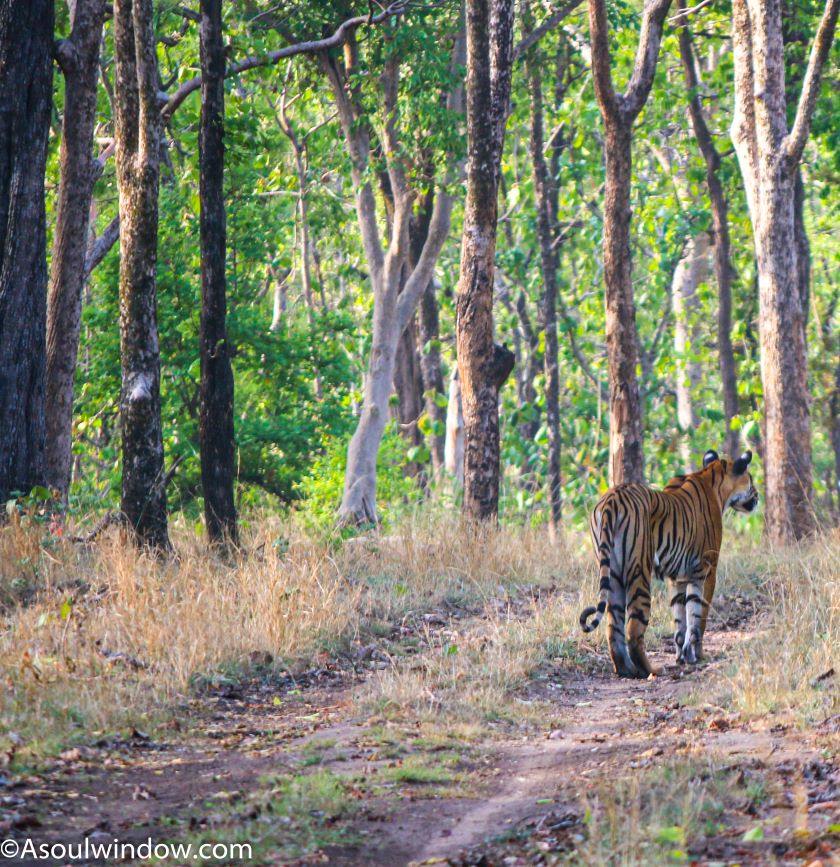
Tiger Safari in Pench National Park
Can we see tiger in Pench? What are the chances of sighting tiger in Pench National Park? These are frequently asked questions. Yes, it is easy to spot Royal Bengal Tigers (Panthera tigris tigris) in Pench National Park. It was, at least during the several morning jungle safaris I did here.
The game of calls went for a long time. We even saw several Chitals gamboling around and the otherwise playful Hanuman langurs climbing up on the tree, looking visually disturbed. But tiger was nowhere to be seen. Then suddenly we realised, we are the only one in the area we were in. This means that the safari jeeps had parked themselves elsewhere in anticipation of a tiger sighting. We wheeled away at popular spots for tiger sightings and it turned out to be the right decision.
A female tigress was slowly moving around, with not a care in the world through far away thick jungle. The visibility was very clear because it was peak of summer when we saw her. Then she slowly emerged out of the woods into a clear pathway. Just before she moved away, she stopped to poop. Deepa told me that her name is Kalapahad. She was in her prime when I saw her and was trying to expand her territory.
After Kalapahad disappeared, we moved on to another spot known as Kuvanallah, Sapat. This is where another tigress with her cub had been spotted by some. More than the tigress, I was amazed by the beautiful landscape of this place. Small grassy hills interspersed with water bodies spread for as far as my eyes could see. From the binocular, I even saw an Indian Roller, unafraid of the tigers, goofing around with a wooden pole. I could even spot a herd of chital deer just few meters apart from the tiger family. Aren’t they afraid of the tigers or are they just not aware of their presence.
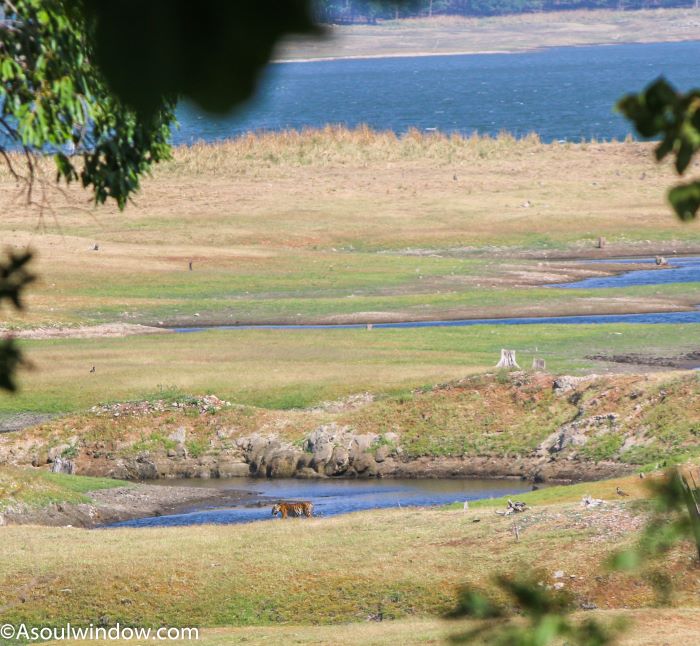
From the naked eyes, I initially thought that the deer were tigers. Because they stood even further away from where tigers sat and they have similar orange and white patches, I was confused. But then the real tiger appeared. There was a commotion at where the jeeps were parked. I reached out for binocular and saw a tiger cub appear out of a rocky shade. After giving darshan for some time the cub disappeared again. After few minutes, another cub appeared. This one gave us a longer appearance as he/she abled lazily towards the water body to drink water. This was the clearest view of the Tiger I got in this spot. After having its fill, the cub retired under a rock nearby. We waited and were rewarded with another tiger sighting. This time, another tiger appeared on the flat surface above the grassy knoll. It was raining tigers and we couldn’t have asked for more.
Both are the daughters of Bijamatta who was a famous tigress in the area we saw her daughters in. Now, she has moved away from that area. The first tigress we saw was Kalapahad and the second one was another of Bijamatta’s daughter with her cubs.
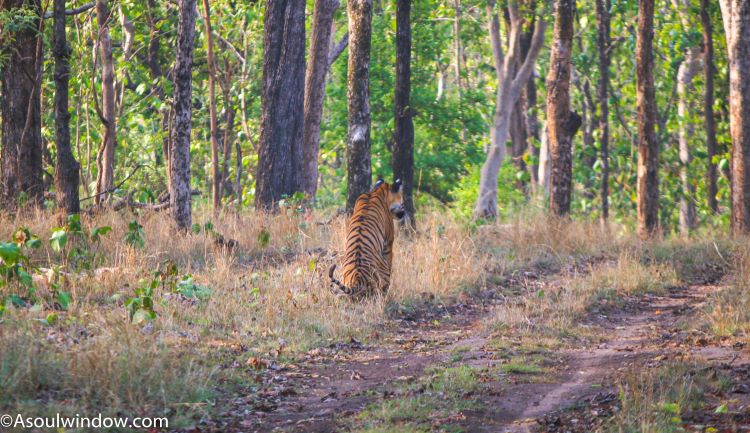
Pench National Park was declared as a sanctuary only in the year 1977. It was not until the year 1983, that it was announced as a National Park. It was eventually established as the 19th Tiger Reserve area of India in the year 1992. No wonder, the population of Royal Bengal Tiges have only risen since then, thanks to all the sincere conservation efforts taken by the governments and forest officials.
Do visit Kuvanallah, Sapat for its ethereal beauty if not for tigers. Lush green meadows, blue skies, aqua water bodies and hilly terrains make Kuvanallah, Sapat one of the best places to see in Pench National Park. Do share this comprehensive guide to top things to do in Pench National Park with friends and family.
Spot Indian leopards at Pyorthadi
It was a heart pounding moment. I saw my first Indian leopard (Panthera pardus fusca) in wild on both the morning jeep safaris in Pench National Park. My naturalist Deepa told me that the rocky Pyorthadi area near the Junewani waterhole is known for its great leopard sightings on a regular basis. I wasn’t expecting much but I jumped off my seat when I saw hordes of people on jeep directing their telephoto lenses and binoculars towards a rock. Even my safari jeep driver, who was silent till now, got all excited when he spotted the leopard.

On the first day, I saw a leopard cub sleeping on a rock. Some people had also seen the mother of the cub walking away from the rock. The leopard sighting on the second day was way better. The (possibly same) leopard cub gave us a good look till we got bored. In no hurry to move away and unfazed with our presence, the leopard cub posed and preened lazily, while yawning and appearing half sleepy. “Really, what do animals even do all day? They have no other work than to just eat, sleep and breed.”, I asked myself.
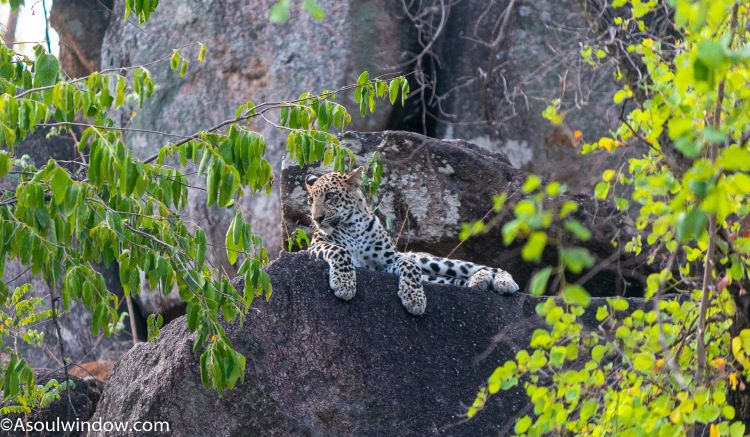
On another occasion, many jeeps had parked at a dirt track. Almost all of them could see a leopard eating something in far distance. Despite several attempts with binoculars, I failed to see the other leopard. This leopard was sitting pretty far away, camouflaged by the brown woods. But I couldn’t ask for more as I saw 2 leopards on both days in Pyorthadi. Since, it was also my first leopard sighting in the wild, I was not being greedier. Now you also know why Pyorthadi is top place to visit Pench National Park.
It’s a small climb which goes up Pyorthadi from the picturesque Junewani waterhole. Even if I had not spotted any leopards here, the scenery of red soil interspersed with big rocky boulders, reminiscent of the boulders I saw in Lepakshi and Hampi are reasons enough to include Pyorthadi in your jeep safari. Deepa from Pugdundee Safaris, who accompanied me on the jungle safari also made me notice the colossal Ghost Trees and sparkling Salai Trees.
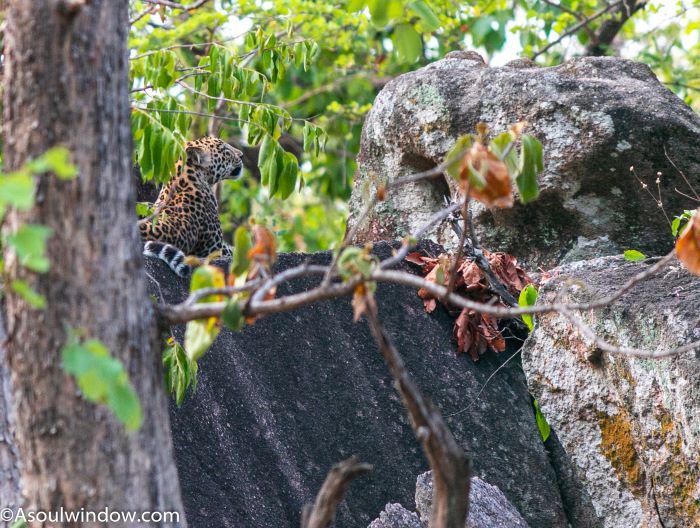
Dholes or Wild Dogs Sighting
“Dholes are even rarer than tigers both in numbers as well as the possibility of their sightings.”, said Deepa to a wide eyed me. No wonder, it was the first time I ever saw a dhole in the wild despite so many previous safaris. The other hired guide from the National Park wasn’t very excited and keen to ‘waste time’ here. And urged the driver to move ahead. I asserted that I sure want to stop for some more time looking at the dholes. “I don’t care if I don’t see a tiger today but I really do want to observe the behaviour of the dholes to my heart’s content.” I declared desperately as the driver switched on the engine. “Can you please shut down the engine, the dholes are far away and I am trying to take a sharp shot.”, I requested the driver.

Soul Window Moments
Then magic happened. The pack of 7-8 dholes came running towards us in a walk dissimilar to the stray dogs or even the secretive foxes and jackals. I noticed that the dholes have a similar demeanour of hyenas. The same restlessness, the same boldness and the same lack of civilised behaviour. The dholes I saw were rough, quick moving and unafraid of human presence. I even saw 2-3 dholes fiercely chase away a Hanuman Langur up a tree. “Had they caught the langur, it would have been an unsightly event”, I imagined in horror. I don’t know why no one says this, but I find them very similar to the hyenas. Much like hyenas, the dholes also attack in packs and are ruthless in their hunting style. Even the big animals stay away from the dholes, thanks to their ‘uncivilised’ ruthlessness. I saw what they are capable of when they surrounded the langur from all corners.
The number of dholes who stay together as a pack can range anywhere from 7 to even 40 in rare cases. Though mostly clans between 5-12 members have been observed. Much like the bush dogs of South and Central America, the dholes also practise handstand urination when marking their territory. I noticed that suddenly some of the dholes started to poop right in front of our safari jeep. They were marking their territory. One of the dholes came right near our safari jeep and lied down on the ground and rolled playfully. Much like the African wild dogs and unlike wolves, dholes are not known to attack humans.

Dholes have been listed as endangered species on the IUCN Red List. Thanks to factors such as loss of prey, competition with other species such as leopards and tigers, habitat loss, kleptoparasitism, persecution by villagers due to livestock predation and diseases transferred from domestic dogs etc, the numbers of dholes are dwindling over the years. It was therefore heartening for me to see a healthy pack of 8 dholes actively moving from one corner to other. Also found in Satpura Tiger Reserve, Debrigarh Wildlife Sanctuary and Bandipur National Park in Karnataka, dholes can also be spotted feeding on a sambar or chital carcass during the jeep safari.
Lacking a dominance hierarchy, the highly social dholes have many similarities with the African wild dogs in when it comes to their social structure. Dholes also find a mention in Rudyard Kipling’s Red Dog. It is a little-known fact.
Apart from India, dholes are also found in Central Asian nations such as Pamir Mountains of southern Kyrgyzstan, Pakistan, Tibet, Nepal, Bhutan, Myanmar, Bangladesh and other parts of China etc. Indian Dholes are also called as Indian wild dog, red dog, Asiatic wild dog, whistling dog and Asian Wild Dog. The scientific name of Indian dhole is Cuon alpinus.

Do safari in canter
Jungle Safari in canter is very common in Pench National Park. Suitable for large families, solo travellers, budget travellers, large groups of office colleagues and friends traveling together, canter van is a popular mode of transport within Pench National Park. During my tiger safari here, I noticed only 1-2 canter vans roaming around the jungle.
The advantage of canter safari is that it is low-cost. However, disadvantage of canter van is that you may not get a good vantage point or the driver may not stop for every little animal or bird you want to see. Another disadvantage is that the canter may not show you the hidden gems of Pench National Park. Canter Safari is the best thing to do in Pench National Park for budget travellers.
Hire a trained naturalist from Pench Tree Lodge
As we embarked upon the jungle safari, Pench Tree Lodge by Pugdundee Safaris also made sure that their in-house naturalist Deepa from Chennai in Tamil Nadu also accompanied us on all occasions, be it jeep safari or shooting in the underground Kipling Hide. I am glad it happened. Deepa, the naturalist from Pench Tree Lodge, Pugdundee Safaris, changed the way I looked at the jungle. Not only did she make me see the small details but also kept sharing interesting information on wildlife which I didn’t even know I should ask about. Erudite, English-speaking naturalists like Deepa are rare to find. Deepa had a ready reply on any question I asked about the wild.
What makes the naturalists of Pugdundee Safaris like Deepa different is that they are very observant, smart, well versed with the animal and plant behaviour and never shy away from any question. Deepa suggested me many books if I want to go deeper in my study of the wild. Though I feel, she herself is qualified to write a book on wild. And so were others from Pench Tree Lodge, whether it’s the manager Harish or assistant manager Shaan, each staff of Pench Tree Lodge is a treasure trove of knowledge.
Study Flora of Pench National Park
My naturalist Deepa from Pugdundee Safaris educated me about the local flora as we wheeled away inside the dense Pench National Park. Whether it is the invasive lantana species or the local mahua, teak, bamboo, ghost tree, crocodile tree etc, she shared some very interesting lesser-known facts about the trees and shrubs. The ghost tree I saw had a strange pink hue instead of stark white. Noticing my befuddlement, Deepa intervened, “The ghost tree changes bark every 4 months, that’s why we may see pale green, pink bark in different parts of the year.”
While driving in the core zone of Pench National Park, Deepa diverted my attention to a tree growing above a big rock. “It is known as rock fig. It grows on rocks.”, she said. Also known as wild pipal, Indian rock fig, rock pipal or waved-leaved fig tree, people often mistake it with the peepal tree, commonly found in India. Though rock fig (Ficus arnottiana) and peepal (Ficus religiosa) may look same from a distance, they are very different.
On another occasion, Deepa made me appreciate the beauty of camel’s foot climber (Phanera vahlii). This perennial creeper of the family Fabaceae had entirely covered a tree in a beautiful jhalar like fashion. Native to the Indian subcontinent, thecamel’s foot climber may grow as much as 50 feet or 15 meters a year. Some people also eat its seeds after roasting. The bi-lobed leaf looks like a foot of camel, that’s why it is called so.
Just as we were leaving the jungle, Deepa asked the driver to stop. “That is a strangler Fig on your right.” The huge tree itself seemed like a matter of study to me. Unlike its civilized urban counterpart, the strangler Fig or wild banyan strangles its host tree as is commonly seen in the jungles of Central India.

Seeing our curiosity, Deepa added, “Strangler figs are hemiepiphytes, which means that they do not have roots in the ground in the initial part of their life. The seeds of strangler figs are often dispersed by various birds. Eventually they start to germinate in the crevices on the upper parts of the host trees. With time, the seedlings start to grown their roots and move downwards while also moving upwards, tearing the canopy, in search of sunlight. With time, the strangler fig ‘strangulates’ the host tree as it envelopes the latter from all sides. It is even common for the host tree to die after it is ‘strangulated’ completely.”
This is why I keep saying that the jungle is not always about the tigers only. The three types of forests found in Pench National Park are
- Southern tropical wet deciduous forest
- Southern tropical dry deciduous teak forest
- Southern tropical dry deciduous mixed forest
Some of the main trees and plants found in Pench National Park are as below:
- Saja
- Salai
- Amla
- Tendu
- Palash
- Pickle
- Plum
- Lendia
- Mahua
- Haldu
- Guular
- Dhaora
- Moyan
- Amaltas
- Jamuna
- Rock Fig
- Bijiayasal
- Strangler Fig
- Kahua (Arjuna)
- Camel’s foot climber
- lantana (invasive species)
- While kulu tree aka ghost tree
Learn about the invasive species
Over one third protected area of Pench National Park is dominated with dry mixed forests. Open forests of displaced areas of old villages also fell on our route several times during the jeep safari. During the jeep safari, Deepa showed me the undergrowth of lantana. “Lantanas are invasive species brought by the British as a decorative shrub. In Pench National Park, you can see lantana not only carpeting the forest ground but even climbing over trees as a creeper. Unfortunately, lantana can also be found entangled with other native plants.
Study Fauna of Pench National Park
Which animal is famous in Pench? Are there bears in Pench? Are there leopards in Pench? These are some very commonly asked questions. Pench National Park in central India is one of the best places for wildlife exploration because of the high density of animals and birds. It is very common to ignore the chitals or spotted deer when doing a wildlife safari. But how much do we really know about chital?
Here is an interesting fact about the deer. Do notice the salt licks or chattan, the white and cratered patches of earth when you go on a jungle safari next. This moon-like soil has a high calcium content which attracts various species of deerwho sniffs it out and then lick to grow their horns. In Jim Corbett National Park, I saw similar scenes of deer perched atop a vertical mountain to lick off its minerals.

Mammals found in Pench National Park
You can expect to spot below mammals in Pench National Park:
- Jackal
- Hyena
- Weasel
- Wild cat
- Leopards
- Chinkara
- Palm civets
- Jungle cats
- Black bears
- Indian civets
- Sambhar deer
- Nilgai or blue ox
- Royal Bengal Tigers
- Dholes aka wild dogs
- Gaurs aka Indian Bison
- Four-horned Antelope or Chousingha
- The Indian giant squirrel or Malabar giant squirrel (Ratufa indica). It is also known as Flying squirrel.
Birds found in Pench National Park
As many as 325 different species of birds have been recorded in and around the biodiverse Pench National Park.
Some of the birds found in Pench National Park are as below:
- Munia
- Pintail
- Egret
- Herons
- Minivet
- Oriole
- Wagtail
- Shoveller
- Waterfowl
- Indian roller
- Indian Myna
- Ashy Drongo
- Spotted dove
- Magpie robin
- Common Iora
- Crow pheasant
- Red junglefowl
- Grey junglefowl
- Asian flycatcher
- White tailed iora
- Red-vented bulbul
- Southern Coucal
- Brahminy Starling
- Grey bellied cuckoo
- Indian pond heron
- Black hooded oriole
- Common kingfisher
- Racket-tailed drongo
- Lesser whistling teal
- Spot Breasted fantail
- Black naped Monarch
- Oriental Magpie Robin
- Peacocks and peafowl
- Chestnut tailed Starling
- White breasted waterhen
- Crimson-breasted barbet
- Chestnut shouldered Petronia aka Yellow-throated Sparrow
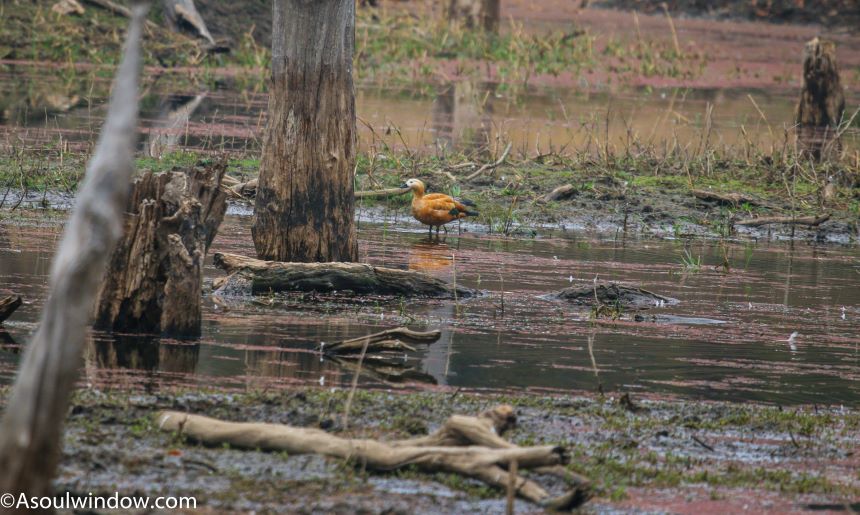
Migratory Birds
- Pintail
- Vegtel
- Ruddy shelduck
- Whistling Teal
Is there elephant in Pench National Park?
Surprisingly, there are no elephants in Pench National Park. This was confirmed by my naturalist Deepa. You may sadly see some domesticated elephants, which is sad. Animals like elephants, I feel belong in the wild and must not be domesticated.
Mud Puddling: Learn about the butterfly behaviour
While my eyes were hungrily looking for the big cats, Deepa made me appreciate the smaller details we often miss despite spending hours in a forest. Near a water body, Deepa made me notice a large congregation of Lime butterfly (Papilio demoleus) and common emigrant butterfly (Catopsilia Pomona). Thanks to its habit of its habit of migration, common emigrant butterfly is called so. It is found in Asia and even Australia.
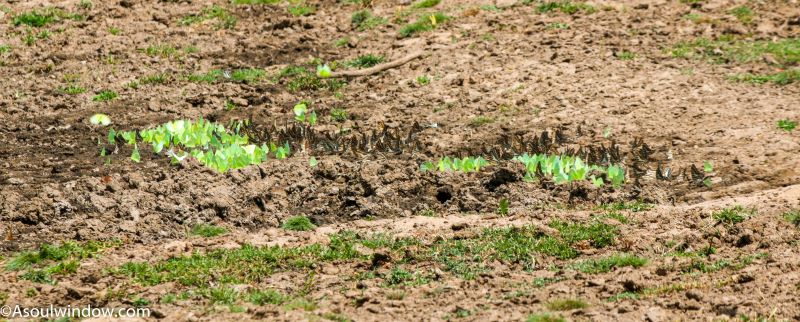
Deepa told me, “Also called as chequered swallowtail, lime swallowtail and lemon butterfly, lime butterfly is called so because they choose the leaves of citrus trees as the host tree for laying eggs. Their caterpillars/larva thus feeds on leaves of citrus plants.” These are lesser-known amazing facts.
Deepa further asked me to notice the behaviour of the butterflies. She added, “You can see the male common emigrant butterflies doing mud puddling, a process which helps them obtain minerals from the soil. Later, they pass on the minerals to female while mating.” During mud puddling, butterflies as well as many other insects uptake amino acids and sodium from the mud. They may do so even from dung and urine of mammals or even from decaying flesh. It is more commonly seen in the post-monsoon season in India.
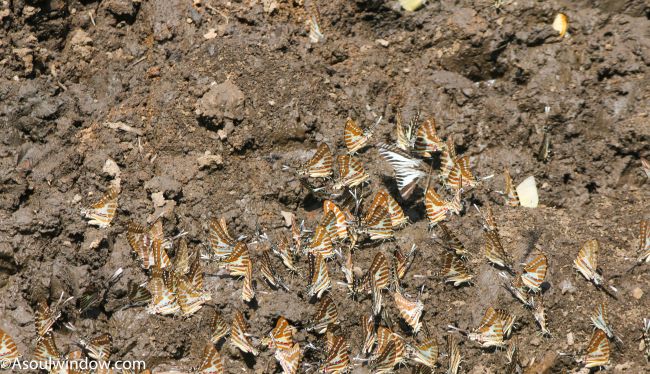
A little ahead we saw a large group of male Swordtail butterflies doing mud puddling as well. Swordtail butterflies get their name from the “tails” on the back edge of their wings that look like a sword. “Nothing happens without a reason in the jungle”, I ruminated as we resumed our pursuit of the big cats.
Birdwatching in Pench National Park
There are as many as a whooping 210 species of resident and migratory birds in and around Pench National Park which is a paradise for bird watchers. While doing jeep safari, we saw many birds such as the grey hornbill. We saw Indian gray hornbill (Ocyceros birostris) several times during the safari, flitting from one branch to another. On another occasion, we noticed crested serpent eagle (Spilornis cheela) on one side of the road and changeable hawk eagle (Nisaetus cirrhatus) on another side. It is also known as the crested hawk eagle.
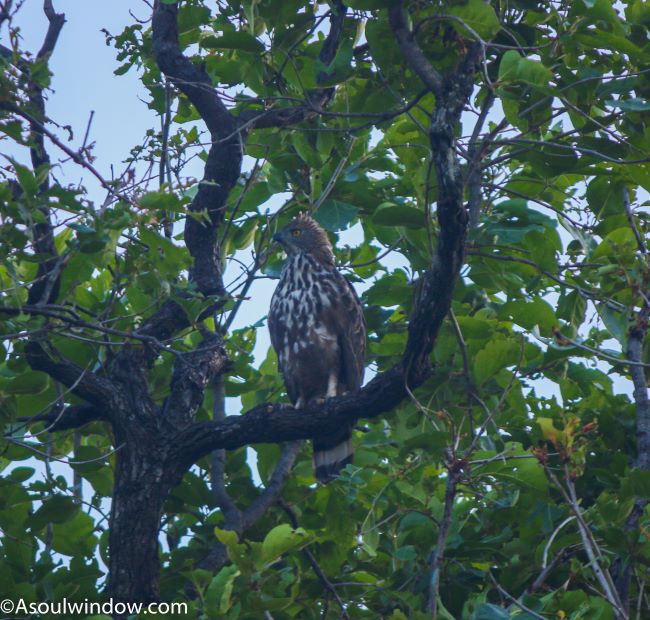
In fact, a hyper rufous treepie (Dendrocitta vagabunda) was fighting off the changeable hawk eagle who rather looked unfazed. A little ahead we saw a cute pair of half sleepy mottled wood owl (Strix ocellata) perched atop a tree. Well camouflagedbehind the leave sand branches, theygroomed each other without a hurry. Mottled wood owls are a large species of owl. We probably saw a fleeting glimpse of a flying mottled wood owl during night safari in Tadoba National Park as well.
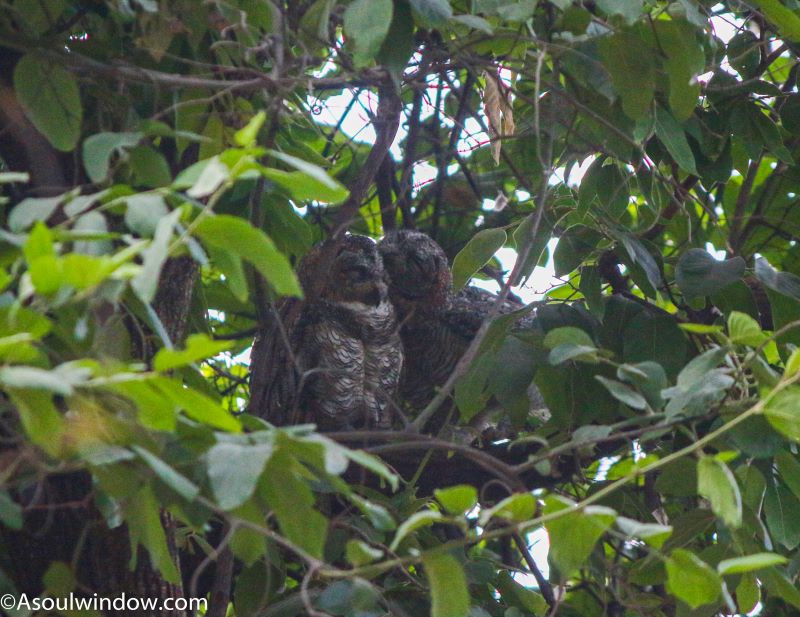
Deepa further made us notice, “That is a Brahminy starling (Sturnia pagodarum) from the Myna family. It looks like common myna or Indian myna (Acridotheres tristis) but it’s different. In a beautiful pond, she diverted our attention to another bird, “That is an Asian woolly-necked stork or Asian woolly neck (Ciconia episcopus). Its appearance is like that of a coat of lawyer, which is why it is also known as lawyer bird.
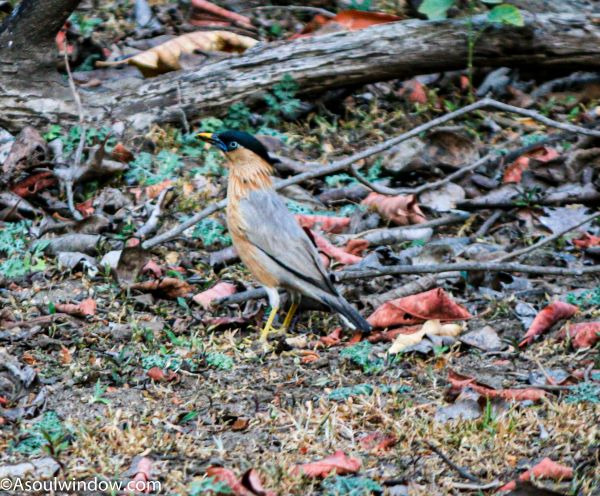
Birdwatching at Kipling Hide of Pench Tree Lodge
I have done bird photography from a hide in many places such as Shitlakhet of Almora and Sattal but never before had I seen a professionally designed, underground wildlife photography hide as I saw right behind my tree house in the luxurious Pench Tree Lodge. Hides are man-made concealed areas where photographers are able to stay close to the wild birds and animals by ‘hiding’ themselves from their view. This helps in achieving amazing images and videos of wildlife without disturbing them.

I think it is a genius idea by Pench Tree Lodge management to keep our eye level aligned with the anticipated movement of the birds by making an underground hide instead of a building above the ground. The unique eye-level perspective from a close distance made it all the more worth it to stay here from 3 p.m to 6 p.m. daily since both of my safaris were in morning. Now you know why Pench Tree Lodge is easily the best hotel in Pench National Park.
While doing bird photography in the underground Kipling Hide of Pench Tree Lodge, I found it easy to train my telephoto lens on the birds which appears suddenly, flits around, bathes in the artificial pond and flies a way in a jiffy. Pond not only serves the purpose to attract animals and birds but it also helped me achieve reflection images of birds such as fantail from the eye level. During my 6 hours of two days which I spend in hide I saw many birds coming to the water, to either drink or bathe. Now you know why birdwatching is easily the best thing to do in Pench National Park.
Some of the birds I saw and clicked from the Kipling Hide are:
- Ashy Drongo
- Spotted dove
- Southern Coucal
- Brahminy Starling
- Grey bellied cuckoo
- Black hooded oriole
- Spot Breasted fantail
- Black naped Monarch
- Chestnut tailed Starling
- White breasted waterhen
- Indian pond heron in breeding plumage
- Common Iora (white tailed iora is very rare to spot)
- Oriental Magpie Robin male and female (male is darker)
- Chestnut shouldered Petronia aka Yellow-throated Sparrow
- Asian flycatcher (We also saw male Asian flycatcher who has a longer tail)
We also saw ground skimmer, a variety of dragonfly. Naturalist Deepa from Pugdundee Safaris who always accompanied me on all the sessions in the hide, asked me to use the bean bags kept on a side for a better stability for my DSLR camera. I was delighted that the mere use of bean bag made a huge difference to the sharpness of the images. This is why, you should always use bean bags for stability of camera.
It is surely the most unusual underground wildlife photography hides in India or elsewhere which I have seen. What’s more, they even had arrangements of fan, tea, water etc in the hide. It felt like I am entering the underground bunkers of Jaswantgarh war memorial near Tawang in Arunachal Pradesh. I was able to stay close to the wildlife safely and discreetly.
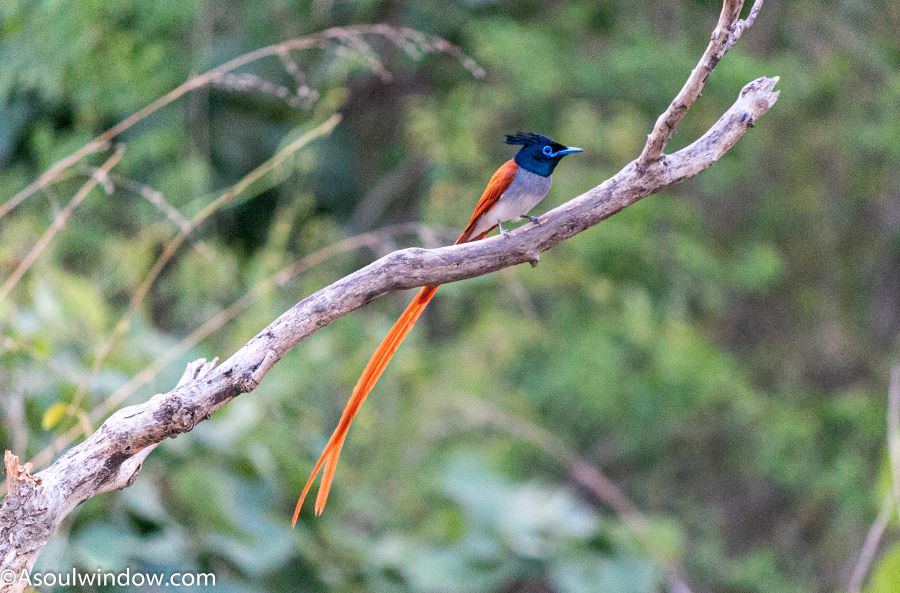
Not only does the Kipling hide serve as an observatory for those who are keen to deeply study the behavioural patterns and movements of various species of endemic birds, but it is also a great way to bring down your carbon footprints. I didn’t really drive anywhere for photography in the hide. I merely walked out of my room to enter the Kipling Hide. What better way to do sustainable, greener and low impact engagement with the wildlife than to experience the wild from a close distance in a in vehicular alternative? You may even want to stay in Pench Tree Lodge for a longer duration and document/record the natural behaviour of animal and bird species and their interaction with each other.

Birdwatching at Kohka Lake
During the walk around the periphery of the vast Kohka Lake, I spotted many birds such as spotted owlet, crested serpent eagle, oriental white eye, Indian Pitta, osprey, grey-headed Fishing Eagle, ashy-crowned sparrow lark, ashy prinia, Tickell’s blue flycatcher, Kingfishers, lesser whistling ducks, spot billed duck, red vented bulbul, Common hawk cuckoo, ruddy shelducks and Indian roller or Neelkanth. Some wildlife properties arrange for a jeep ride to Kohka Lake and even a high tea by the lake. I had enjoyed breathtaking views of a mesmerizing sunset from the Kohka lake as I returned from the walk around the dense jungles nearby. We had to cross Touria village and some other small villages to arrive at Kohka Lake. I did birdwatching in Kohka Lake in evening. You may also end up watching wild boar rooting in the swampy edges of the pristine Kohka lake.
Catch a Jungle cat at the Kipling Hide
Even if a rare appearance of leopard or any big cat happens, I will be safe inside the hide. On a rare occasion, a leopard was also seen drinking water from the artificial hide which was built by the Pugdundee Safaris management to attracts birds, animals, insects etc. The rare jungle cat is a regular visitor here. In fact, they had spotted a jungle cat early morning by the pond in the live CCTV in the reception area. I was unable to see the jungle cat from the hide as I was away doing early morning jeep safari in Pench National Park. “The jungle cat usually visits the Kipling Hide at around 7 a.m, in the morning.” Harish told me as I waited for my safari jeep at 4 a.m. The good part is that I did have a good look at the jungle cat during the night safari in Tadoba National Park on the same trip.
Visit Totladoh reservoir
Totladoh dam is a great place for not only picnic but also birding. The gravity dam on the Pench river attracts many migratory birds during the winter months, i.e. November, December, January and February. You can spend half a day at this lesser-known tourist attraction of Pench National Park. It is an ideal place to bond with your friends and family. Do carry your DSLR camera and telephoto lens if birdwatching attracts you.
Feel the jungle
I found my peace while I was driven through the natural habitat of wild creatures in a jungle full of exotic floral species and water bodies. The soothing rhythm of nature calmed me as I discovered new facts about the jungle. It is one of the major tourist activities to do in Pench Tiger Reserve. Whether it is experiencing the sights and sounds of wild creatures in their natural habitat or admiring the visually delightful landscapes of this beautiful forest, there is never a dull moment here. The jungle is easily the best place to visit in Pench National Park.
Runi Jhuni Nature Walking Trail
Just as I entered the Karmajhiri gate of the Pench National Park from the nearby Pench Tree Lodge, where I was staying, a signboard vied for my attention. For a reasonable fee, you can walk around the marked trails inside the designated spots of Pench National Park and observe the local fauna and flora from a close distance. The offbeat Runi Jhuni nature walking trail begins fromthe Karmajhiri gate. Expect to spot some species of deer, wild junglefowls, Hanuman langurs and a plethora of exotic bird species.
It is equally thrilling to observe claw marks left by animals like sloth bears on the trees. Animal poop, alarm calls, animals tracks and even tiger pug marks are commonly observed during the walking trail. Apart from observing the plant life closely, you can also expect to see wild boars, red jungle fowls, Hanuman langurs, chital and exotic species of colourful birds during the nature trail. It sure is one of the best offbeat things to do in Pench National Park.
The Runi Jhuni nature walking trail, which is accessible from the Karmajhiri gate, spans 3-4 kilometres and lasts anywhere between 1.5 to 2 hours. It is mandatory to hire a local guide appointed by the government. Located within the Pench National Park, this is the closest engagement with the wild you can do. Not all national parks allow to walk in the jungle. However, Deepa, the naturalist from Pugdundee Safaris who accompanied us for jeep safari said, “Tiger movement has been observed in this area since last few days, therefore it is indefinitely closed.” This is why you must ask around, if the Runi Jhuni Nature Walking Trail is open or not. Pench Tree Lodge conducts the Runi Jhuni nature walking trail and their package includes transportation, all taxes and guide charges as well.
Explore Kohka Lake
Walking along the shores of the placid Kohka lake is therapeutical. Some luxury hotels can also arrange for a high tea by the lake upon request during sunset. Having a high tea by the lake is the best offbeat thing to do in Pench National Park.
At times, tigers have been spotted around the Kohka Lake as well. Walking around the huge Kohka Lake is one of the best tourist activities in Pench National Park. I did birdwatching around the picturesque Kohka Lake.
Night Safari in Pench National Park
Night Safari is easily one of the top thrilling adventurous activities to do in Pench National Park. It is a very unique experience not available at other national parks of India. More than spotting the wild animals, it is the feel of the jungle in the night which makes it once in a lifetime experience. The thrilling night safari can only be booked over the counter and not online. You can even spot Royal Bengal Tigers, leopard and sloth bears during the offbeat night safari in Pench National Park like my friends did.
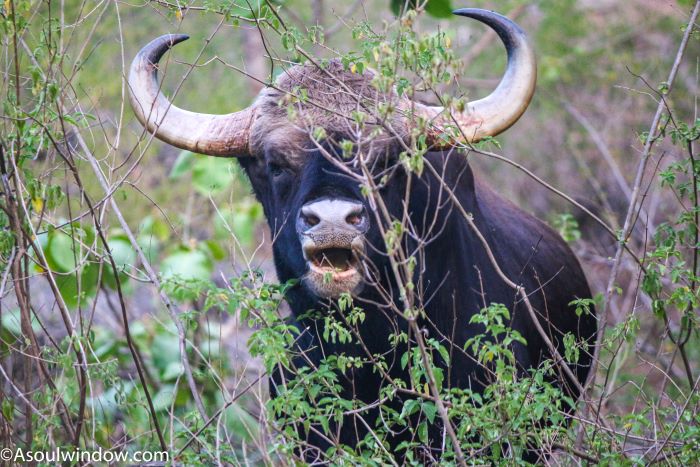
During the night safari in Pench National Park, you can expect to spot several nocturnal birds such as the nightjars. Mammals like wolves, nilgai, Indian wild hare, spotted deer, gaurs, wild boars, jackals, sambhar deer, various snakes, spiders and unique frogs are also commonly seen during night safari in the buffer zone of Pench National Park. What made night safari a really thrilling experience for me is the fact that it gave me deeper insights into the nightlife of animals, birds etc and their behaviour. Wild creatures like owls, civet cats, hares and porcupines etc are active after dark only.
However, the most thrilling experience is when you see an elusive civet cat, jungle cat, tiger or even leopard during the night safari in the buffer zone of Pench National Park in a safari jeep. It is also possible to see the rarely seen Indian Grey Wolf in the Wolf Sanctuary. Wolf movement is commonly observed in some areas around the dense green forest.
The duration of the night safari is between 2 and 3 hours. Night Jeep Safari timings in Pench National Park are 6 p.m. to 9 p.m. Night safaris take place in the buffer zones of Turia gate as well as the Karmajhiri gate, both of which I have entered. The Kumpani Tikari Buffer Zone is also very popular. The 30 kilometres long track kms passes through hilly areas and straddles between the buffer and core zone. The beautiful Pench River also lies on the way.
Night safari is the best thing to do in Pench National Park. You may also want to read about my very successful night safari in Tadoba National Park where I saw my first civet cat and jungle cat.
Stay in the luxurious Pench Tree Lodge
Where to stay in Pench National Park? Pench National Park is easily one of the best wildlife resorts in Pench National Park. I have stayed in many places in Pench National Park and I conclude that the architectural wonder that the Pench Tree House is, it is one of the best places to stay in Pench National Park. I remember attending Satte Awards few years ago when Pugdundee Safaris were awarded as the best in their category. Now I know why. They have 7 luxurious properties (and growing) in 6 National Parks of India viz Bandhavgarh, Kanha, Pench, Satpura, Panna and Tadoba.
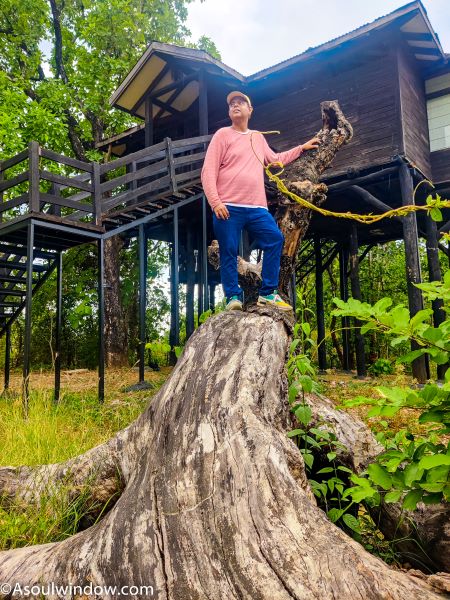
Staying in Waghoba Eco Lodge in Tadoba National Park and Pench Tree House in Pench national Park on the same trip was such a pleasure. From great food to luxurious amenities, big wide spaces to in house naturalist, this award winning Pugdundee Safaris has everything going for it. I sure want to come back for more. Pench tree lodge near the Karmajhiri gate of Pench National Park is easily the most unusual place I have ever stayed in. Perched atop stilts, this ultra luxurious tree house is built with the robust Sal wood. Located in the Sarahari village of Pench, there are no second thoughts that Pench Tree House indeed is the best place to stay in Pench National Park.
As I left the Waghoba Eco Lodge in Tadoba National Park, I took a 5-hour long cab ride on smooth roads to arrive at the breathtakingly beautiful Pench Tree Lodge. It was a childhood fantasy for me to be able to stay in a tree house. Built entirely out of sal tree and stone, the huge tree house at the luxurious Pench Tree Lodge are the stuff dreams are made up of. Perched atop stilts, a live tree is incorporated in the design of most of the 6 tree houses scattered around 40 acres of wilderness.
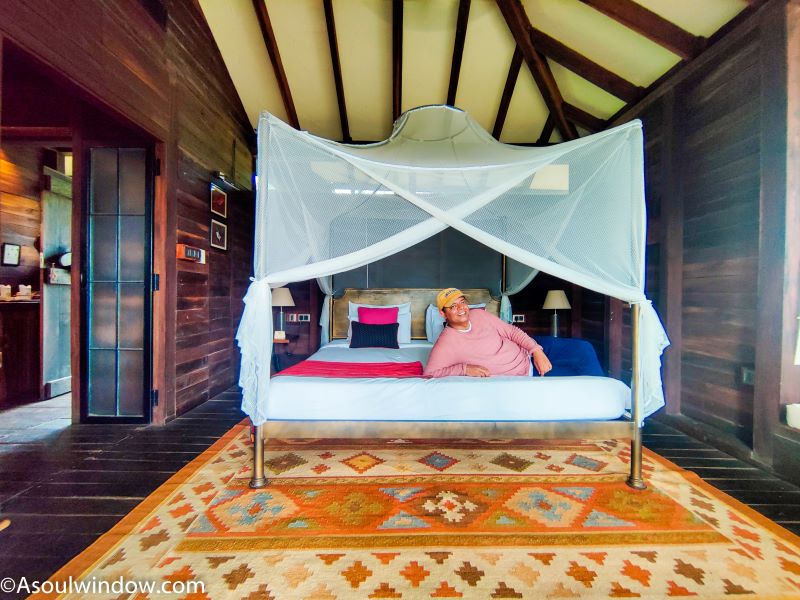
Crashing on my King Size bed with a huge variety of pillows and mosquito net for the cover was comforting after a 3-4 hours long Tiger safari in Pench National Park. The cozy room of Pench Tree Lodge is dream like. Whether it is the lovely sit out area overlooking the dense forest or the tall ceilings or the writing desk, located right next to the huge balcony, each aspect is tastefully done. The room also has plug sockets compatible with international devices which I was carrying with me. The safari themed décor, furniture and local crafts made it stand apart.
Since this tree house is constructed entirely out of dark sal wood, the floors are also wooden. But it is a different kind of wooden. Instead of the thin wooden tiles which we are accustomed to, the dark wooden floors here are kept as natural as possible. It felt like I was actually walking on a wooden log, thereby keeping me in harmony with the nature. What’s more? The balcony of the tree house is equally entwined with nature. Some of the tree houses here a live tree piercing through the balcony and the entrance (like mine did). I brought alive the Mowgli in me as I rested on one of thick stems of the tree in the balcony. You sure want to call this unique Mowgli den your home for a few days.
“In night, you can also expect to see civet cats right in your balcony.” Shaan, the assistant manager told to an excited me. When I arrived in the sprawling property, Shaan had escorted me to my room and also briefed me about the various features of the room. Harish Arya, the manager, casually told me, “The CCTV within the property caught a tiger cub in the camera few days ago. He/she was sitting around the parking area. Even a leopard was spotted drinking water from the artificial pond in front of the Kipling hide.” The rooms even had a Fire exit for emergencies.
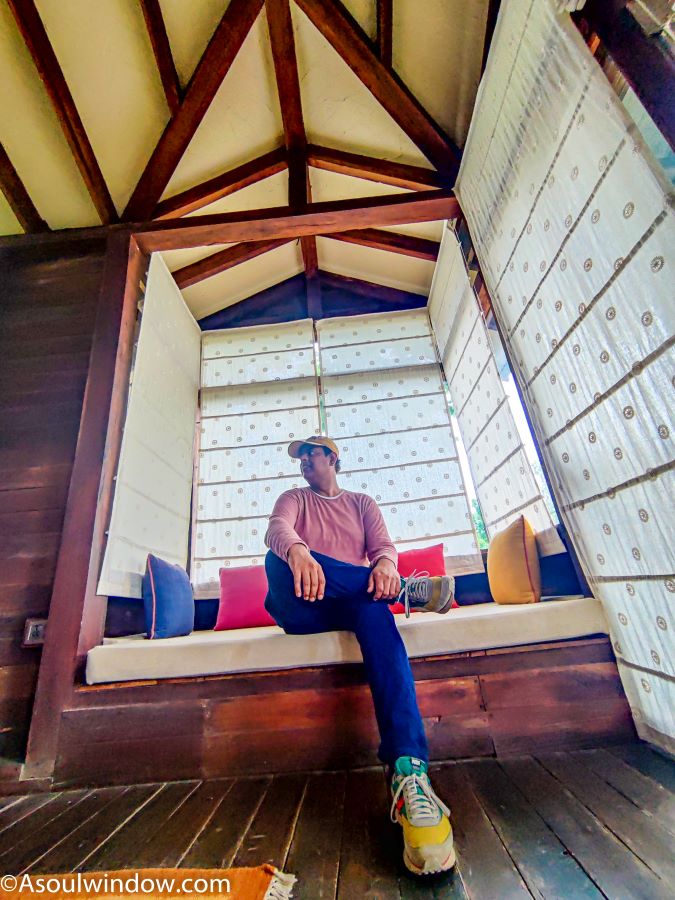
Washrooms
Special mention must be made about the tastefully done washrooms of the Pench Tree Lodge. It surely is the most luxurious and aesthetically beautiful washroom I have ever experienced in the many luxury hotels I have stayed in so far. I loved the attention to detail. From luxurious bath fittings, chick blinds, aromatic toiletries to mood lighting and provision for natural sunlight made me want to spend more time in the classily done bathroom. Even the peg for hanging clothes which had animal faces was carefully selected. In fact, I spotted several exotic birds right from the window of the washroom of Pench Tree Lodge.
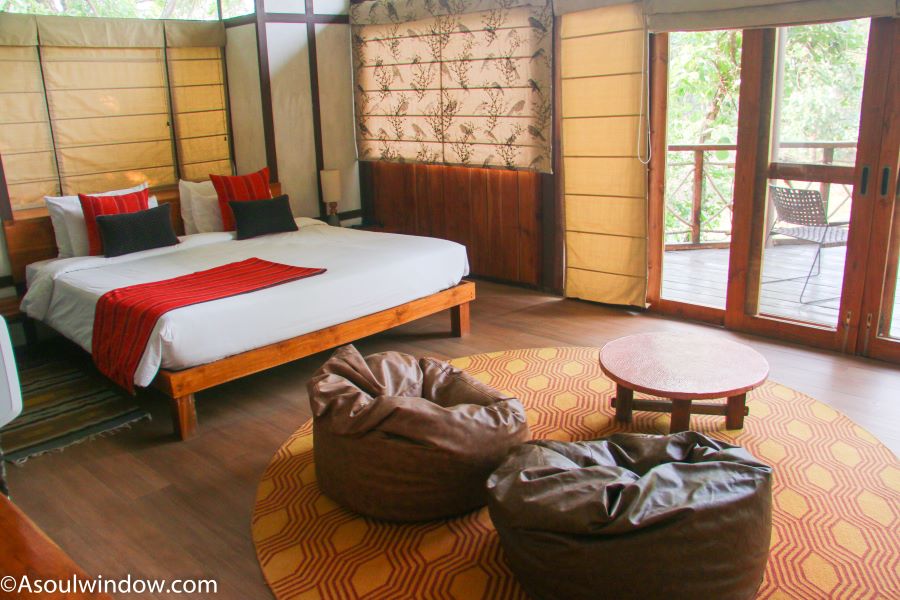
Branches of trees touch the window, ensuring you are never away from the jungle. The shower area is separated from the washbasin and WC area with a glass wall. What I loved about the shower area was the heavy stone slab beneath my feet. To be able to take shower above a natural stone slab made me feel more connected with the mother earth, a feeling I never got bathing above the tiles. You may miss it while staying at the Pench Tree Lodge but if you pay attention to details, you will realise the conscious efforts which have been taken by the management to keep the tree house as natural and organic as possible. This, without compromising on the comfort or luxury. What’s more, they have even placed a chair by the window in the washroom. This was a first as well. The bedroom and the washroom areas are separated with a small vestibule with luggage racks, wardrobes, lampshades and a section for the coffee tea making machines.
About Pugdundee Safaris
Apart from Pench, Pugdundee Safaris also have hotels and resorts in other tiger hubs such as the nearby Tadoba National Park, Kanha National Park, Satpura National Park, Bandhavgarh National Park and Panna National Park. Their tree houses in Bandhavgarh and Pench National Park are an architectural wonder and are thus very popular with nature lovers. I have stayed in the tree house in Pench National Park and it was an experience like no other. In fact, you can club both Waghoba Eco Lodge (Tadoba) and Pench Tree Lodge on the same trip like I did. They are just 5 hours of cab ride apart.
Stay environment conscious
What I loved about the Pench Tree Lodge was the fact that they are sincerely committed to keep their carbon footprint to the bare minimum. All Pugdundee Safaris properties take environment, sustainability and the aversion to overcrowding seriously. Their sincere commitment towards environment and conscious luxury is also why they keep winning so many awards. The recent awards won by Pugdundee Safaris are ICRT Awards 2022 & Outlook Indian Responsible Tourism Awards 2022.
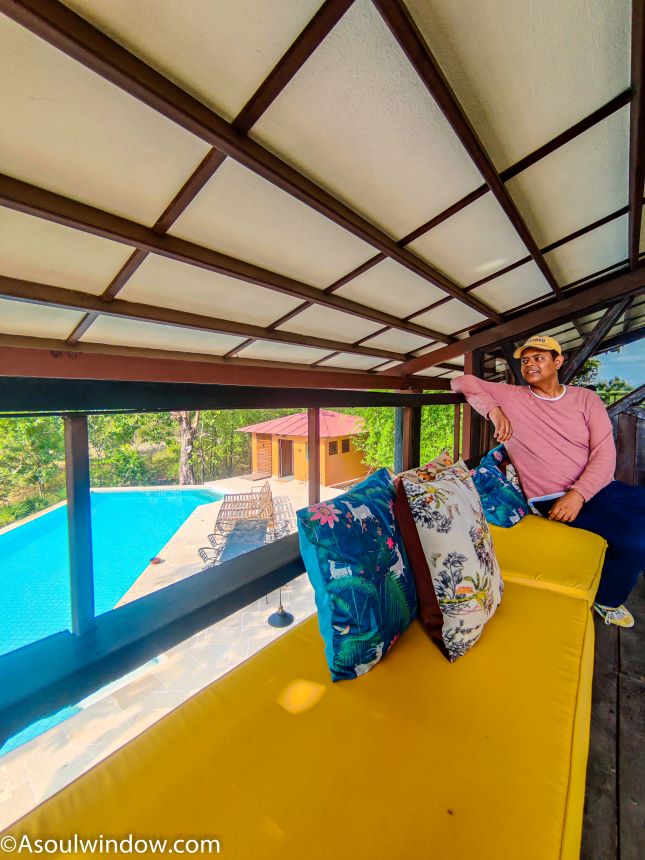
I observed that there is more wild grass and wide-open fields here than buildings. Spread across 40 acres of wilderness, staying here is akin to staying in a jungle. This ensured that I spotted several colourful birds while merely going to their restaurant from my Tree House. This luxurious hotel in Pench National Park is completely in tune with nature which is a rarity. You can even book an in-house nature trail at Pench Tree lodge.
Admire the landscape of Pench National Park
Words fail to describe the scenic beauty of Pench National Park. The numerous water streams, verdant forests and rivulets which dot the landscape of the Pench National Park are reasons enough to pay a visit here. There was a place near the centre point of Alikatta, which I had christened as the golf course of Pench National Park. Despite being wild, this area, full of grassy knolls and water bodies, looked like a manicured golf course. We also drove parallel to the backwaters of Pench river on many occasions. Waterfalls, rock pools and streams are a constant companion here.
Even if you fail to see a tiger, you must enjoy your wildlife holidays here, appreciating the stunning landscape of Pench National Park. River Pench, the lofty Satpura range, large swathes of land carpeted with fallen dry leaves of towering teak and dry deciduous forests make Pench National Park a visual stunner.
Spot snakes and other reptiles of Pench National Park
I have spotted keelback snake in both Kohka lake as well as around the premises of the Pench Tree Lodge by Pugdundee Safaris. The fast-moving keelback snake is locally known as aka dhoriya. AsI was strolling within the sprawling Pench Tree Lodge, a long reptilian creature whizzed past me in a hurry. Earlier I thought its some large variety of skink.
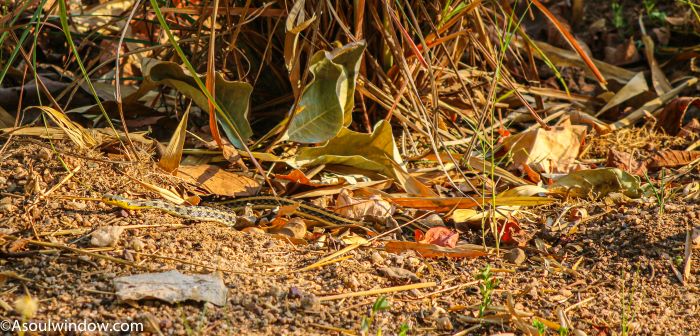
Deepa corrected me, “It is a Buff striped keelback snake (Amphiesma stolatum). They are not venomous andfeed mostly on small insects, toads and frogs.” Closely related to the water snakes and grass snakes, the Buff striped keelback snakes are harmless and not a threat to humans.
I also spotted the stunning looking Rock Agama or red headed agama (Agama agama) several times within the property premises. It is commonly found across India. The red head and the black body give the rock agama a beautiful appearance. We also saw a huge Indian monitor lizard during the safari in Pench who tried to fool us by camouflaging himself/herself with the bark of a tree.

Enjoy local cuisine of Madhya Pradesh and Maharashtra
I am a fan of Maharashtrian cuisine. This is why it delights me when some properties serve authentic local food such as Jhunka Bhakhari and the very spicy thecha (chilly chutney). Local deserts such as Puran poli and tilli gujhiya and Shrikhand left me begging for more on previous trips here.
For lunch, Chef Pankaj Fulera at the Pench Tree Lodge served us a special thali known as the ‘Panch Gaon Andar’ Thali. The dishes in this elaborate and healthy thali consisted of dishes made in the home kitchens of villages located within a radius of 50 kilometres from Pench Tree Lodge. For dinner, we had a Burmese Khowsuey and an elaborate candle light farm dinner (read more about it in this blog).
The menu of Panch Gaon Andar thali consisted of:
- Tewda Daal
- Chatpata salad
- Fresh Potato chips
- Moong Daal ko pakodi
- Corn paanka (corn tikkis)
- Laal saag or Chaulai saag
- Glueberry pickle or lasoda achaar
- Gawar fali ki sabji or cluster beans
- Dal Bafouri (prepared with moong daal)
- Bhune lahsun tamatar ki chutney (tomatoes and garlic roasted in charcoal)
- Lapsi (Aata halwa cooked with jaggery)

New age dieticians such as Rujuta Divekar has inspired me to eat seasonal locally available, fresh and sustainably sourced food. I was glad that the Waghoba Eco Lodge is committed to serve exactly such food. In the books of Rujuta Divekar, shehas also warned against consuming packaged food, refined food and food which has added colours, excess salt, artificial flavours and additives. Thankfully, Pench tree house, much like Waghoba Eco Lodge in Tadoba stays away from all of this. All the dishes cooked here are made from scratch from the locally sourced raw ingredients.
When you stop at the canteen for a loo break and breakfast, do not forget to taste the ‘famous Alu Bonda of Alikatta’ from the local cafeteria. They also serve tea, pakoras etc. I found the shaded seating arrangement of the otherwise al fresco dining area comfortable despite traveling here in the hot month of June.
Indulge in a bar
Is liquor allowed in Pench National Park? While liquor and any form of alcohol is not allowed to carry inside the core zone of Pench National Park, you may enjoy it at a licensed restaurant around the forest. Many hotels like Pench Tree Lodge have an in-house bar that lets you select from a wide range of alcoholic drinks. Pench Tree Lodge also had a wide selection of non-alcoholic beverages and mocktails.
Do a candle light farm dinner
On the first day itself, we indulged in the candle light farm dinner organised regularly at Pench Tree Lodge. This al fresco dining under the stars takes place right next to the large kitchen garden of the property. Besides a romantic candle light dinner, I also enjoyed sampling authentic dishes from Madhya Pradesh such as desi alu(potato dish), dal barbati (Yard long bean) etc. Other dishes served in farm dinner are Angari Alu, Ajwaini Daal Barbati, Garden Salad, Corn Bharta, Paneer Tikka etc. All the dishes are cooked live in the unique black clay ovens and pots. It reminded me of black pottery of Ukhrul from Manipur which is also known as Longpei (Nungbi) pottery practised by the members of the Tangkhul community.
And do not miss the Dobri Mahua Kheer for dessert. In this unique sweet dish, Mahua flowers are cooked with rice pudding. You can’t get more local than this! The al fresco bar is creatively set up on a traditional bullock cart, lighted with village style laalten or lantern around it.
Cycling in Pench National Park
A wildlife holiday in Pench National Park is incomplete without cycling. Much like I enjoyed cycling around Jim Corbett National Park in Uttarakhand, I was delighted to see many properties in Pench offering cycling facilities too. Tourists can hire a cycle and explore the surroundings at their own whims and fancies and pace. Cycling amidst the wilderness is appreciated by those who value silence and tranquillity.
The best part is that cyclists are allowed to stop at various points if they want to spot birds and animals. The months of November, December, January, February and March are better suited for cycling, thanks to the pleasant weather. Although I enjoy cycling in the early morning and evening in the summer months as well.
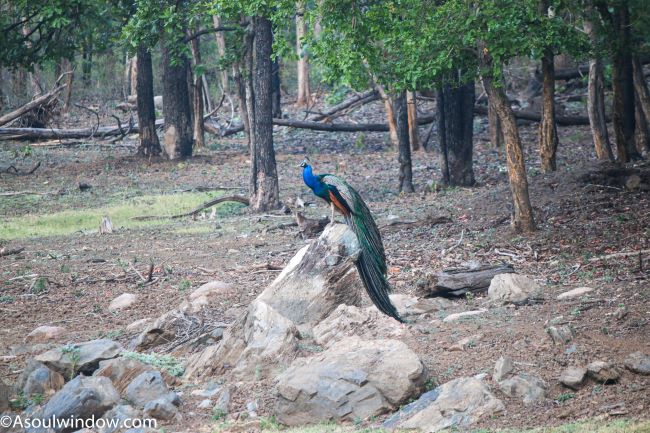
Visit Rukhad Sanctuary
Not many people know that Rukhad Sanctuary lies in the Kanha-Pench Tiger Corridor. It is a lesser-known fact about Pench National Park. It is possible to spot chitals, langurs, gaurs, sloth bears, Royal Bengal Tigers and even leopards playing hide and seek in the predominantly bamboo and teak forests.
In my opinion, it is a great idea to go cycling in Rukhad forests known for its exotic wildlife, a variety of floral species and scenic terrains. Rukhad forests lie in the buffer zone of Pench National Park in Madhya Pradesh. You can embark upon the 22 kilometres long guided cycling tour at around 8 a.m. in the morning. The cycling tour typically ends at around 12 p.m. the Sakata Forest Rest House. This is surely one of the best offbeat things to do in Pench National Park.
On request, Pench Tree Lodge by Pugdundee Safaris regularly organises cycling and jeep safaris to Rukhad Sanctuary. Pench Tree Lodge and Rukhad Sanctuary are just 45 minutes of drive apart. Breakfast is served before the cycling expedition begins and lunch is served at the historical Sakata Forest Rest House. You can also do a jeep safari here between 3 p.m. to 6 p.m.
Stop at Sakata Forest Rest House
Located within Rukhad Sanctuary, Sakata Forest Rest House merits a visit for its unique architecture and colonial history. Constructed in the year 1903, Sakata Forest Rest House will transport you to an era when the British ruled India. The tiled roofs and pillared open verandah of Sakata Forest Rest House look like perfect melange of British and local architectural styles. Some tour operators also organise camping and trekking expeditions from Sakata Forest Rest House. The 3 Forest Rest Houses are located in Turia, Karmajhiri and in the centre of the Pench National Park. There is no separate entry ticket here. It is the free thing to do in Pench National Park.
Stay in the middle of the jungle
Can you stay inside Pench National Park? Yes, if you fancy staying deep inside the jungle surrounded by pitch dark wilderness, then you must book one of the official accommodation facilities available at the Rukhad Forest Rest House, Karmajhiri Gate and Ghatkohka. You can make an advance booking of the stay over phone and email. Your tour operator may also be helpful in booking the same for you. The Field Director of Pench Tiger Reserve however, reserves the rights of reservation. Staying in the jungle is absolutely the most thrilling thing to do in Pench National Park. Do carry a torch, water, snacks and mosquito repellent before arriving here because not many facilities are available in such remote locations.
Machan Watch: Climb atop a watchtower
It is in fact one of the best things to do in Pench National Park. There are various machans or watchtowers installed across the Pench National Park by the forest officials. You may want to stop at some machan and wait for the animals and birds to appear. Since, the viewing platform is located on a raised platform, it offers sweeping bird’s eye views of the forest and surrounding areas. These machans are a major tourist attraction in Pench National Park.
Go on Nature Trails
You must go with a government appointed guide for safety concerns. I noticed small details such as quick sand, insects mating, webs of spiders, camouflaged moths, forts of termites and nest of ants as I walked above the large carpet of dried teak leaves, secretly anticipating a tiger popping out of the woods and locking eyes with us.
Night Jungle Walk and morning trekking in the green jungle is also offered by some tour companies in Pench National Park.
Learn about medicinal plants
Some hotels of Pench National Park also take guests on medicinal tours where they explain about how the local adivasis or tribal people use the local plants and shrubs for medicinal purposes.
Relive your childhood with stories of Mowgli and Jungle Book
Just as I entered the premises of Pench National Park, I was teleported to the setting of the real Jungle Book, engulfed in the world of Mowgli, Bagheera, Kaa and Sher Khan etc.
Soul Window Memories
On every Sunday, I grew up religiously watching the animated version of Jungle Book on Doordarshan in the glorious 90s. Even after so many decades, we all remember the ‘Jungle Jungle Baat Chali Hai, Pata Chala Hai’ song verbatim. Even after so many decades, I still play the jungle book song sometimes on YouTube for guaranteed goosebumps. This song makes me emotional, more now than when I was a child. Now, I always fail to sing this song without a nostalgia laced lump in my throat. Perhaps, because it also reminds me of my lost childhood and the other things from that era which I loved and lost over the years. If this is not the epitome of nostalgia, then what is?
And who can forget the moment when the frame freezes while Mowgli sitting atop Bagheera and accompanied by his cheerful adoptive wolf parents, gallop in front of the full moon? But then the lyricist for this song, Gulzar has always aimed for the nothing less than the moon.
This is why for the 90s kids, it is a special moment to visit the Pench National Park. It was thrilling for me at least to be able to pay a visit to the actual jungle which inspired Rudyard Kipling to write”The Jungle Book”.
It is said that the pamphlet “An Account of Wolves’s Nurturing Children in their Dens” by William Henry Sliman. Inspired the character of Mowgali. Another account says that the semi-autobiographical ‘Seonee’ by R.A. Strendale inspired the Jungle Book.
In fact, in the year 1831, the news of a child who grew up with wild wolves in village Satbavadi near Seoni (earlier Seonee) spread like wildfire (pun not intended). For perspective, Rudyard Kipling wrote jungle book in the year 1894.
You can still visit the actual places in the Seoni district which were mentioned in the Jungle book. Foor example, the mountain ranges of village Kannivara and Sivani actually exist and so does the Vainganga River and its valley where the character of Sher Khan was killed.
During our special lunch (more on that in the food section of this blog), my friend Ami made me observe the beautiful paintings of Mowgli and other characters from the Jungle Book on the walls of the restaurant of the Pench Tree Lodge.
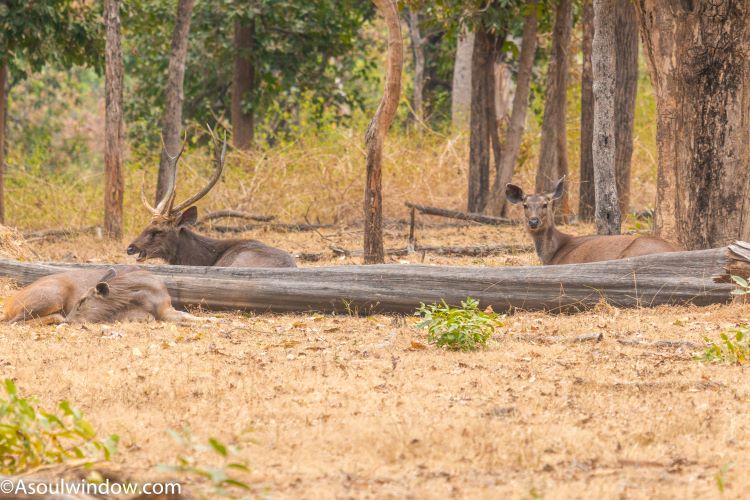
Go on an educational tour
Educational tours for school going kids are arranged on a regular basis in Pench National Park. While I never had this opportunity in my childhood, I feel engaging kids with wildlife at a young impressionable age is important. Not only will it educate the kids about the other animals, birds, insects and plant lives we share this planet with but it also sensitises them towards other living beings. As a parent, you must encourage your kids to participate in educational tours to Pench National Park and elsewhere.
Visit Kalapahad
Located on an elevated land, Kalapahad is where you can tear off to Chhindimatta in one direction and Alikatta in other direction. Kalapahad is popular with wildlife enthusiasts and adventure lovers alike. As per a signboard by Madhya Pradesh Tourism Board,
“Kala Pahad or Black Mountain is an outstanding mountain of black, brown rocks. Such rocks are only found in Ireland in Europe, which are millions of years old.” (sic)
Kala Pahad is a popular picnic spot and a nice tourist place. Located in a secluded place away from the crowds, it is one of the top offbeat attractions of Pench National Park. Tourists come to Kala Pahad to see its very unique patterns. Formed entirely of black and brown rocks, it is one of its kind of a place in India. You can also trek up and visit a Shiva temple on the top.
The rocks here appear as if someone is hired to cut them into pieces with sawing machines. From Kala Pahar, you can also enjoy breathtaking views of the green valley and towering mountains in the far distance. Kala Pahad is also the highest point in Pench.
Visit Junewani Waterhole
The unexplored Junewani Waterholeis located near Kala Pahad. This visually stunning pond is frequently visited by tourists in search of wildlife. Even if you do not see any animal or bird here, rest assured that the visually stunning reflections of dead and alive trees here will compensate for the same.
Visit Baginnalla waterhole
Baginnalla waterhole is one of the best places to visit in Pench National Park. Surrounded with Acacia Catechu trees, Baginnalla waterhole is famous for sightings. Enjoy the sweeping views of vast scrublands, small water streams and mixed vegetation as you drive around in this area. Baginnalla waterhole, JodaMunara and Pyorthadi are also located nearby.
Camping in Pench National Park
Some people also do camping in tents at night. Though it adds more thrill and delight to the Pench National Park trip, but it is not everyone’s cup of tea. If you can rough it out in the jungle in pitch darkness, go for it. Yayy or nay, Overnight Camping sure is one of the most adventurous things you can do in Pench National Park. Though some tour agents also add bonfire as well as music to the overall camping experience, I am wary of it. As a responsible traveller, I firmly hold the view that fire and music should be kept away from the jungle.
The campsites in Pench National Park are mostly surrounded by dense forests and sometimes even a lake (which means that wild animals are nearby). Tour agents who organise overnight camping with activities at Pench also offer village walking, temple visits, trekking, nature walks, village walks, jungle safari and other thrilling things to do in their package. You can also play cricket/badminton or just lazily lie in the hammock all day.
Plan an offsite in Pench National Park
I am wary of big groups coming to eco sensitive places such as Pench National Park. However, if done responsibly, corporate houses can plan a very unique offsite in the hotels and resorts of Pench National Park. Many hotels offer team-building exercises and facilities which are ideal for an offsite.
Explore the tribal haat or village bazaar
After leaving the Waghoba Eco Lodge in Tadoba National Park, as we were approaching The Pench Tree Lodge near the Karmajhiri gate of Pench National Park of Madhya Pradesh, we made a quick stop at a place known as Suktara for snacks etc. I noticed a haat where local people sold things on a raised cemented platform. These haats or weekly markets are very commonly seen around Pench National Park. Suktara is hardly 15-20 minutes of cab ride away from the Pench Tree Lodge. These traditional tribal haats are a must-visit place to see near Pench National Park.

For an immersive experience of the local tribal culture, do visit haat in the local villages of Khamba, Badalpar (Thursday), Belpath (Sunday), Chakkikhamari (Monday) and Vijaypani (Tuesday) etc. These villages are located very close to Pench Tree Lodge and they can arrange for a visit here on request. Vijaypani, Belpath, Badalpar and Chakkikhamari are located merely 3, 6, 10, 12 kilometres away from Pench Tree Lodge respectively.
Keep your eyes peeled for unique spices and condiments which you may have not seen elsewhere. Indigenous crafts and locally made products are also sold in haat. You may even want to pack some for back home. Mahua related products are also commonly sold in such weekly haats. Also commonly sold are the organically grown fruits and fresh vegetables, sourced from the nearby villages which have organic farms. You must take a self-guided free walking tour in the haats around Pench National Park.
Do Wildlife Photography
You can not go to a wildlife destination and not come back with amazing wildlife images. I at least can-not. In case you have the DSLR but not the telephoto 100-400 mm lens, then I would suggest that you hire one like I do these days. The difference it can make to your wildlife photography makes it worth it. I find wildlife photography very frustrating but equally rewarding. You can check out my wildlife photography on my other blogs on wildlife as birdwatching in Sattal, Lakh Bahosi Bird Sanctuary, the adventurous snake trail in Agumbe, the kangaroo paradise of Tidbinbila Nature Reserve. I also got some great images from my visit to the Kidepo Valley National Park and Bwindi Impregnatable National Park.
Soul Window Wildlife Photography Tips
While doing wildlife photography, I always ask the driver to shut the engine of the safari jeep (this may be tricky in a canter). The shake caused by the engine, can blur the pictures. I understand the excitement you feel when you see the tiger. But whenever possible, I try to calm myself (I know not easy) and even hold my breath before I go trigger happy. Even a small shake of the breath can blur the image. I also use bean bag for camera whenever possible for sharp images. And always-always shoot on the burst mode when doing wildlife photography in Pench National Park or elsewhere.
Make Vlogs
I carried my Go Pro to all the safaris in Pench National Park but soon realised that Go Pro doesn’t work well in safaris because the zoom is not good enough. Thankfully mobile phones are allowed inside the Pench National Park, therefore I was able to take good Vlogs from it. If not professional level, then at least recording workable footages from mobile camera is possible during a safari in a jungle. However, the ideal way to shoot videos inside a jungle is using DSLR camera or even more upgraded equipment but that’s not possible always due to fast movement of animals and birds and the constant shaking of jeep. Carrying small bean bag for camera (like I did) may help to some extent.
Elephant safari
I am against elephant safari for many reasons. First of all, I believe that an elephant you can touch is not a happy elephant. Also, you don’t need to be an Einstein to imagine what 5-6 adults sitting atop a flat surface on the curved back of the elephant for 3-4 hours will do to the spine of elephant. Besides, I have also seen mahaouts ill-treating the elephants by beating them and chaining them all day long. This is why please avoid elephant safari if it is offered to you.
Relax, unwind and rejuvenate
If you have had more sightings than what you had anticipated (like I did), then you may just chill and use the time to relax, unwind and rejuvenate. It is not every day that we get such quality time to spend with ourselves and our loved ones? I feel that the low internet network in most of the places around Pench National Park is a great excuse to connect with more important things such as spending time with loved ones, reading, playing games etc.
Do Yoga
The surroundings of Pench National Park are so calm and serene that it served very well for a yoga session. You can do yoga right in the spacious balcony of the cottages or tree house of Pench Tree Lodge. You must carry Yoga mats or check with your hotel if they can help you with the same. Since Pench National Park is a quick and easy weekend break from Nagpur, you can plan a yoga and safari holiday here soon. Yoga is the most unusual thing to do in Pench National Park. But, why not?
Do meditation
My room at Pench Tree Lodge was so silent and peaceful, that I was tempted to meditate here. Occasional chirping of birds was the only sound I could here from the balcony of my tree house. You could easily sit for hours here, close your eyes and meditate for spiritual elevation.
Enjoy a swim
If you are traveling to the Pench National Park in summer then you must dive into the tastefully done swimming pool of the Pench Tree Lodge. Located right next to their large restaurant, the swimming pool here is the best way you can beat the heat and spending some quality time with your loved ones during the hours you are not heading for a jungle safari. Do carry your swimming costumes with you. And open shower, wash basin, recliners and toilet are located right next to the restaurant. This is one of the best things to do with family and kids in Pench National Park.

Trek in Pench National Park
Jungle trek is another major attraction of the Pench National Park. You must keep your thirst for adventure alive by doing some treks in and around Pench National Park. Jungle trek is another prominent attraction of the Pench National Park. Wade through the thick forest of Satpura, as the expert local guide escorts you through the tricky pathways. You must not try to trek inside the forest solo as it is easy to get lost in the jungle. Also, special permission from the forest officials must be taken before embarking upon a trek in the jungle. The local guides are also well aware of the special zones and what to expect there. The guides are also trained to take you to places which are most rich in biodiversity.
Stargazing: Top Thing to do in Pench National Park
Thanks to the lack of pollution and absence of skyscrapers in the around the Pench National Park, I noticed that there are more stars here than what I am used to see in the big, bad cities of India. Several properties in and around Pench National Park have the facility to engage their guests in astronomical explorations. The best astronomy sessions are done of amavasya or new moon day when the sky is the darkest. The stunning milky way from the telescope is not to be missed. In fact, you can also try astronomy photography aka astrophotography, or astronomical imaging, here. For sure, stargazing is one of the top things to do in Pench National Park.
Try your hand at pottery
It was fun trying my hand in the courtyard of a local potter in the famous Pachdhar village near the Turia gate of Pench National Park. Though I didn’t succeed making a single object out of the clay despite several attempts, but it was fun dirtying my hands. What better way to get an immersive experience in the local culture of the place by entering their homes and participate in activities which provide them livelihood. Nevertheless, we ended up buying some tea cups and other artefacts from the same person whose house we visited. It is satisfying to buy directly from the potters which adds to the local economy.
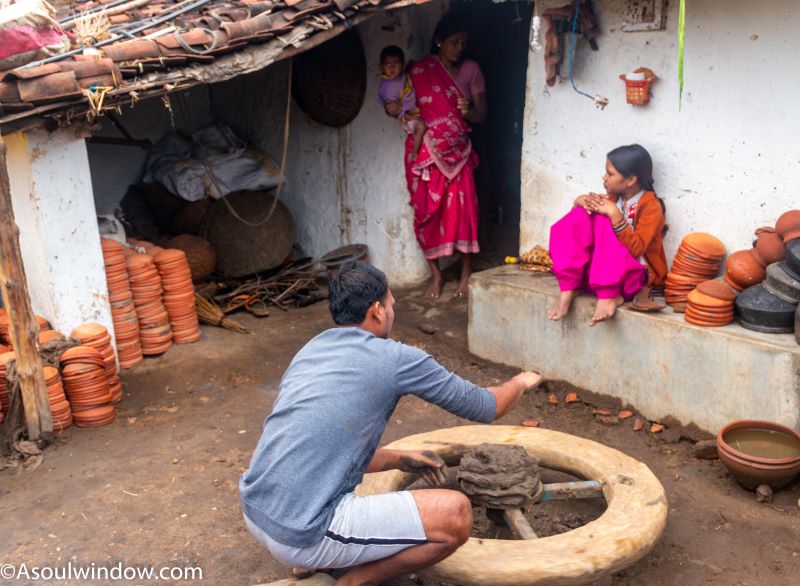
As I walked around the potter’s village, I was told that as many as 100 households practise pottery here. During the village walk, I could see many local villagers deeply involved in making earthen utensils and clay works. Watching the potter’s sit at their wheels making incredible clay works was a revelation. While some villagers make their aesthetic earthen wares and clay utensils in their spacious courtyards, other practise the ancient art in their huge verandas. No mechanical tools are used to make these hand-made organic earthenware.
Visit Pachdhar village
I highly recommend a jeep or cycle ride to Pachdhar Village, if you want to go off the touristy trail in Pench National Park. The picturesque village walks in the Pachdhar village gave me ample opportunities to interact with local tribal village people and gain new perspectives about their traditions, rituals and lifestyle.
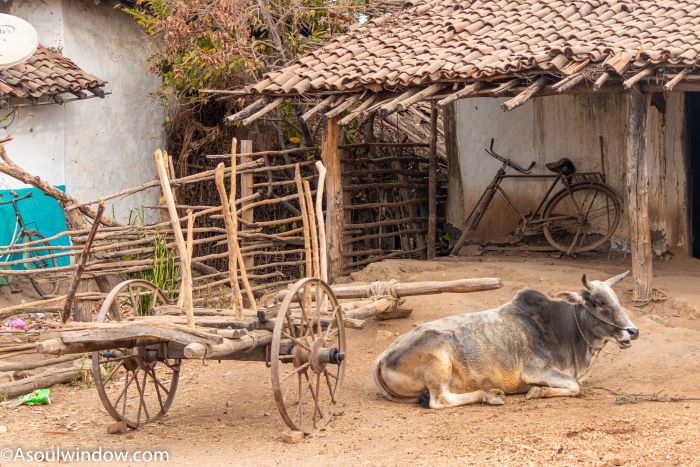
While taking a leisurely stroll around Pachdhar village, I noticed that almost every local house in this quaint village is painted with white and blue colour.
The Pachdhar village is located around 15 kilometres away from the Turia gate of Pench National Park. Being one of the most popular tourist attractions in Pench National Park, Pachdhar village is a must-visit place.
Visit a Gond Temple
While returning from the jeep safari in the Karmajhiri zone of Pench National Park, we stopped midway at the authentic Gond temple. It has no side or entrance walls except for the back wall and roof perhaps more due to the paucity of funds than architectural style. No idols were worshipped here. All I saw were a bunch of trishul (trident) like spears in a rectangular cemented bed. Lemon was pierced into the top of most of the spears.
It was a very unusual sight. I have travelled solo across India since 2008 but I have never seen a temple such as this one. If you know more about the Gond temples, do let me know in the comment section below. This experience sure is a far cry from the other normal tourist activities in Pench National Park. We also saw the Kumba Baba Temple of the Gond tribe deep inside the forest when we entered the core zone from the offbeat Karmajhiri Gate. Gond temples are counted as offbeat places to visit in Pench National Park. I would have missed it had I not been alert and adamant. Hidden gems like these must be explored by the discerning travelers.
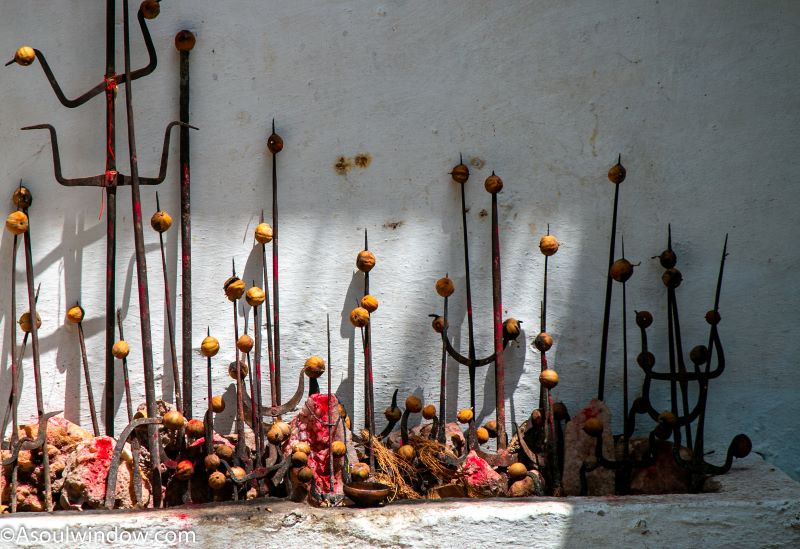
Visit Kuwara Bhivsen
Called as Gond Devsthan, Kuwara Bhivsen is located beside the bank of Pench River near Nagpur. People visit Kuwara Bhivsen for both its spiritual significance as well as scenic beauty. No wonder, Kuwara Bhivsen is a popular picnic spot for locals and tourists alike. You can also visit a beautiful hilltop Shiv Mandir, located beside the river. Nice panoramic views from here are an added bonus. This place is also surrounded by greenery which attracts many birds and animals as well.
Visit a Gond Village
While returning from the Safari in Pench, I, Ami and Deepa stopped at a unique Gond village known as Sarrahiri. In fact, the Pench Tree Lodge is also located within the Sarrahiri village. The local people here are very welcoming and even allow you to visit their homes, with permission. Just a small conversation with a local Gond lady in her home gave me deep insights about the traditions, culture, lifestyle and economics of Gond people. She even allowed me to see her home from inside. Beautifully carved wooden doors and windows, simple one storey traditional architecture of her home and lack of much furniture made me realise that we actually need very less than we think we do. She also showed me a cot she had woven by herself in beautiful patterns and colours.

Village walking tour around the Karmajhiri and Turia gates of Pench National Park is a must do tourist activity, if exploring and learning about the lifestyle and unique culture of tribal people excites you. Gond villages are one of the most popular tourist attractions to see around Pench National Park.
Why Gond people paint their house in two colours? Most of the Gond houses I visited were painted in white in the lower part and blue or green on the upper part. I was told that, “It is painted so in order to spot an insect or small reptiles easily on the lower portion of the house.” These Gond villages are some of the lesser-known tourist places around Pench National Park.
Learn about the Gond Tattoo
Wearing anklet and colourful bangles, the above-mentioned lady also proudly flaunted tattoos on her legs and hand. She told me that the Gond men don’t do tattoos. Locally they call it Godna.

Soul Window Connections
It reminded me of my meeting with tattooed Upper Nocte women of remote Lazu village in Arunachal Pradesh in North East India. Since childhood, she has been wearing tattoos on her body. Much like the women of Lazu village on the border of India and Myanmar, the tattoos of women from Gond villages of Chattisgarh, Madhya Pradesh and Maharashtra in Central India also has specific significance.
While some tattoos may be curative in nature, other tattoos are done at various milestones of life of Gond women such as puberty, marriage and childbirth. These are exactly the same reasons why Nocte women and Wancho women of far-away Arunachal Pradesh tattooed themselves.
Isn’t it strange that two separate tribal communities at two corners of India tattoo themselves for the similar goals. The tattoos of Gond women hold immense ritualistic significance and powers of healing. But much like the Wanchos and Noctes, the younger generation of Gonds are also shying away from tattooing themselves as they leave the village and search for jobs in bigger cities.
Learn about the Mahua economy
The same old Gond woman we met in Sarrahiri village was deshelling mahua seeds as she talked to us. The brown hard shell was separated from the white part which is valued at the market. Deepa told me that, “they roast mahua seeds and make oil out of it. After deshelling, the woman will sell it in the market and add some income to her household.” Mahua is a major source of livelihood for many Gond people and others who live around Central India. In fact, so entrenched is mahua with the collective local culture that several songs, poems and stories themed around mahua have been written.
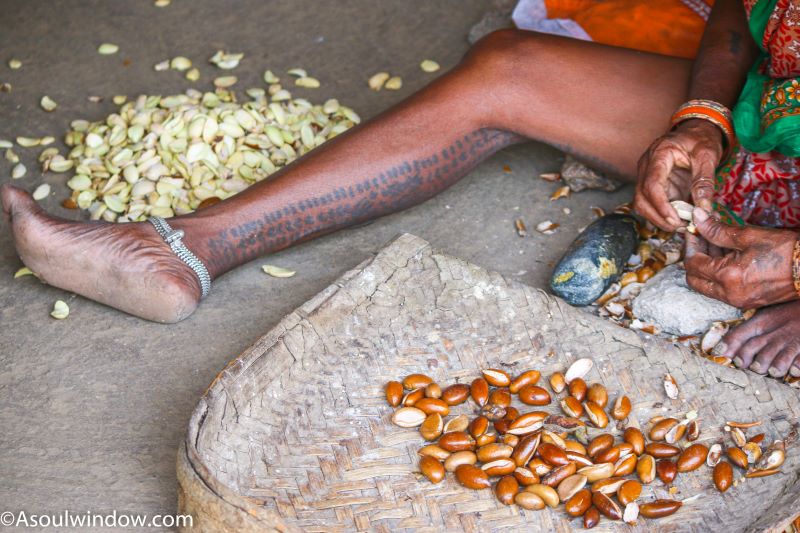
Deepa further told me, “When mahua starts fruiting, they collect the fruit and sell it after deshelling. May and June are the months when you can see local people collecting mahua seeds in the fields. They also make local liquor out of mahua flowers. During the flowering season in late March and April, the local people collect the flowers, dry it, put it in water and let it ferment before making the final alcoholic beverage.” So irresistible are the flowers of Mahua tree that it is eaten by several mammals and birds too. Now you know why mahua tourism is a major attraction in Pench National Park.
Appreciate Warli Art
Warli Art is an ancient art form of Maharashtra. It is common to see Warli Art painted on some of the walls of luxury hotels and resorts in Pench National Park. The good part is that local talents are hired to make these visually delightful paintings, mostly in the combination of white and red. In fact, they can teach you ropes of Warli painting too upon request. Some hotels can arrange this for you. Warli art workshops are some of the top things to do in Pench National Park.
Excursions: Go off the touristy trail
There are many popular tourist places and excursions from Pench National Park. I have written about these in more details on my comprehensive blog on Tadoba National Park. Below are the top popular and offbeat places to visit near Pench National Park:
- Nagpur
- Hinganghat
- Hirapur Dolmen
- Ramdegi Temple
- Ramtek Garh Temple
- Suresh Chopane Rock Museum
- Doctor APJ Abdul Kalam Garden
- Sevagram Gandhi Ashram
Explore Pench Dam and Reservoir aka Kamthikhairy dam
Kamthikhairy dam which is popularly known as Pench Dam and Reservoir offers beautiful views. Tourists can even do boating here. You can hire either a Motor boat or a paddle boat here. Situated in the west range of Pench National Park, near Parshivni in the state of Maharashtra, it is a must-see place.
The earthfill dam was built in order to facilitate irrigation and supply water to Nagpur and Bhandara, 2 nearby districts of Maharashtra. Kamthikhairy dam is located merely 54 km north of Nagpur. Tourists and local people from across Maharashtra and Madhya Pradesh can regularly be seen enjoying at the overflowing Pench Dam or Kamthikhairy Dam on weekends.
Boating near Pench Dam
You can also enjoy Boating near Pench Dam, which is also known as Kamthikhairy Dam. Please ensure that a life jacket is offered to you before you book the boat. You can enjoy amazing views from the boat. Boating, undoubtedly is one of the top things to do around the Pench National Park.
Enjoy the rainy season in Pench
“The jungle is not usually this green in first few weeks of June. You are lucky to enjoy a good weather and lush green forest since it rained a few days ago.”, my guide told me as I was comically trying to find animal shapes in wooden logs from a moving jeep. Pareidolia much, eh!
The beauty of Pench National Park after a few rains is to be seen to be believed. The buffer zones are open during monsoon. So, you can still stay in Pench Tree Lodge and do safari in buffer zone during the rainy season. Tourism in Pench National Park is highly recommended by me.
Buy Souvenirs: Things to buy in Pench National Park
What to buy in Tadoba National Park? My friends bought many local potteries from the Potter’s Village at Pachdhar. The potters sell a variety of locally made pots, cups, mugs, surahi, matka, toys and decorative items made with local clay. Another way to support the locals is to buy their food products. For example, I had also bought the delicious pickles made by local women such as the tangy mango pickle and sweet and sour lemon pickle.
Spend time reading books on wildlife of India
Deepa, the naturalist from Chennai who worked at the Pench Tree Read suggested below books on wildlife, fauna and flora of jungles in India and beyond. Some books listed below also talk about the secred world of plants. Reading some of the best books on wildlife of India as listed below will forever change the way you look at the jungle.
Below is the list of some of the best natural history books on wildlife and plants which share amazing facts:
- Hidden life of trees by Peter Wollebhen
- Trees of Delhi: A field guide by Pradip Krishan
- Jungle Trees of central India by Pradip Krishan
- The Secret network of nature by Peter Wollebhen
- The secret life of Indian mammals by Vivek Menon
- A Naturalist’s journal by M Yuvan Aves, a Chennai based writer.
- Sacred plants of India by Nanditha Krishna and M. Amirthalingam.
- Birds of the Indian Subcontinent by Richard Grimmett, Carol Inskipp and Tim Inskipp.
- Snakes of India -The Field Guide by Romulus Whitaker and Ashok Captain is an encyclopedia on the Indian snake species.
You can also find a mention of the raw beauty of Pench National Park in the following books:
- High Lands of Central India by James Forsyth
- Sivni, Camp life in the Satpura by R.A. Strenthal’s
- Wild Animals of Central India by A. A Dunbar Brander
- Ain-i-Akbari, a 16th century document by Abu Fazl from the Mughal Era in India.
Do not forget to add more suggestions (India or beyond) in the comment section below.
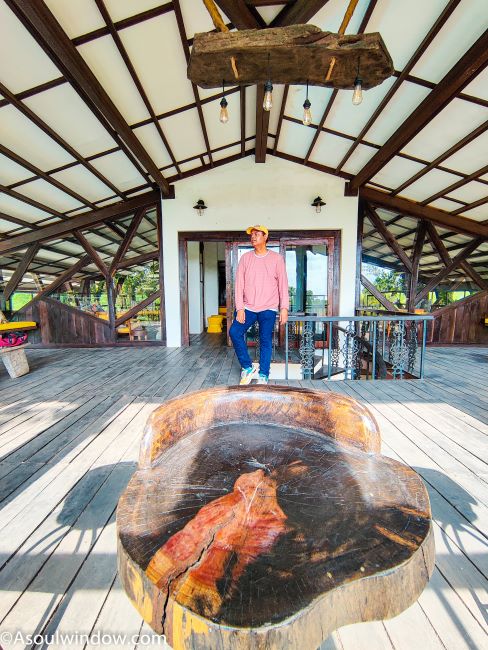
Pick a book from the library of Pench Tree House.
I took a spiral staircase to arrive at the huge library located right above the restaurant of The Pench Tree Lodge. I was impressed with the wide range of books available for readers here. Whether you are a kid or an adult, you will be spilt for choice. Most of the books stocked on several racks here are on themed around wildlife, plant life, and jungle ecosystem. There is also no dearth of seating areas, my favourite of which is the one overlooking the adjacent swimming pool. Made of wood (and not cement), the library is inundated with colourful cushions in bright, primary colours. My friend and co-traveller Ami Bhat also gifted her debut travel fiction book ‘When Places Come Alive’ to the manager Harish. It is a must-read book for those who love to travel.
Enjoy sunsets and sunrise in Pench National Park
I have seen some of the best sunsets and sunrises in and around Pench National Park. While leaving Pench Tree Lodge for the morning safari, I came across a breathtaking sunrise. On the other hand, just as I was winding up with the evening birdwatching session at the pristine Kohka lake, the skies treated me with beautiful sunset. There are many sightseeing places in Pench National Park that offer breathtaking views of sunrise and sunsets.
Visit Sitaghat
Sitaghat is easily the best place to see in Pench National Park. During the jeep safari, we also drove down to the picturesque Sita Ghat area known for good sightings of birds and even the elusive dholes or wild dogs. The voluptuous Pench River was our constant companion as we drove towards Sitaghat. It is a good idea to drive down to Sitaghat in summer months such as April, May, and June because it is common to find tiger (with perhaps cubs) resting by the river. This is also why we visited Sitaghat. Summer is when many water sources dry up, forcing tigers and other animals and birds to visit pools and water bodies throughout the day. Now you know why Sitaghat is a major point of attractions in Pench National Park.
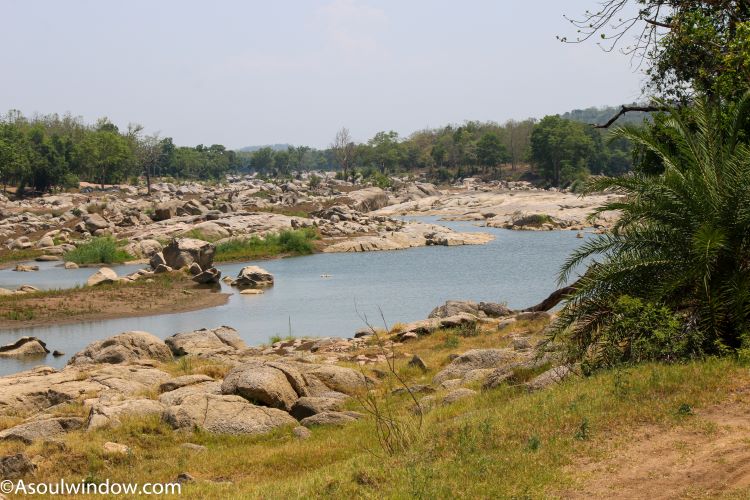
Also, watch out for various flowering trees that make Sitaghat area photogenic. Located on the bank of the river Pench flowing gently through the rocky outcrops, tourists also visit Sitaghat for its raw primeval beauty. Though you can visit Sitaghat throughout the year, except for the rainy season. January, February and March is a good time to be here. Views of Pench River from Sitaghat are breathtaking just after the monsoon season when the river runs full. Think October and November! Sitaghat surely is one of the most unusual places to visit in Pench National Park.
Visit Alikatta
As we entered the core zone from Karamajhiri on a safari jeep, we made a pit stop for breakfast arranged by Pugdundee Safaris near Alikatta which is merely 9 kilometres away from the Karmajhiri Gate. I noticed that hordes of safari jeeps had stopped here for breakfast. The jeeps had entered from various zones of Pench National Park but had congregated here because it is the designated path inside the forest for refreshments and toilet breaks. People also come here to enjoy hot tea, fresh pakora (fritters) and Alikatta ka Alu Bonda. Alikatta sure is one of the most popular places to visit in Pench National Park.
There was once a time when Alikatta used to be a bustling forest village located within the present boundaries of Pench national Park. Such villages are usually established by the forest department so facilitate easy availability of labour employed in forest related work such as cutting of tree and transporting them from one place to another. Such forest villages were mostly established during the colonial times in India by the British who ruled back then. As per a signboard I saw in Alikatta, “The status of the land remains reserved forests and the villagers are given temporary privileges over the land.”

In the years 1994-95, Alikatta village as well as the Chhedia village were relocated elsewhere, away from the forest area. People who once called Alikatta village home were shifted to Durgapur Forest village which is presently situated in close proximity with the nearby NH 7. As of now, Alikatta houses the local sub-range headquarters.
With the goal to encourage a healthy herbivore population, mainly spotted deer or chital, in and around Alikatta, the forest department is committed to maintain the open areas and old agricultural fields as grasslands. No wonder that especially post monsoon, tourists love visiting Alikatta to soak in the views of beautiful green grasslands dotted with the herds of spotted deer grazing in entire surrounding area. You can also spot nesting of Pied Hornbill in trees nearby. In fact, I saw many grey hornbills throughout the day.
In order to maintain the grassland and stop them from converting into an untamed jungle, the forest department regularly uproots any young tree or weed. As per the signboard, “The management tries to promote the growth of palatable species by the chain-link fenced enclosures which preserves the grass during the growing season of monsoon and ensures the seeds setting in the palatable species. Some areas slips of palatable species are planted during the monsoon to restock them,”
What it means is that during the rainy season, the grasslands are protected with a wire fence so that the grasses grown. This ensures that the food is available for herbivorous animals when there is drought like condition in summer months.
Visit Totladoh Dam and Reservoir
Located on the Pench River, which gave its name to the Pench National Park, Totladoh Dam is a must-visit place. Thanks to the natural beauty and greenery around the Totladoh Dam, it is a popular picnic spot for the tourists and locals alike who visit here in large numbers. You can also enjoy breathtaking views from a guest house and garden located here. Located away from the crowds, you can also spot various species of fish, aquatic animals and birds here. In winters, you may see some migratory birds here. This gravity dam on Pench river near Ramtek in Nagpur district is located merely 80 kilometres away from the city of Nagpur on National Highway Number 7. A part of the Pench River hydroelectric project, it is a must-see tourist attraction.
Visit Raiakassa
From the cemented watchtower or machan here, you can soak in the soul nourishing views of the Pench River snaking through huge boulders and rocky outcrops. A visit here during or post monsoon is a good idea because that is when the river is most voluptuous. The roaring sound of the river matches with the roar of the tiger during its peak. The rocky terrain interspersed with the water of the river makes it visually enticing. Also spelt as Raiyakassa, it is situated in the heart of Pench Tiger Reserve. Besides the possibility of wildlife sightings, the excellent view of the Pench River banks is what attracts tourists here.
Dig deep in the map of Pench National Park
Even in the age of Google Map and Waze, I enjoy being old school. I find studying paper maps of places I visit. I spent good time studying the map displayed in the reception of the Pench Tree Lodge. Not only did the map help me ascertain the scale of Pench National Park but it also gave me perspective on my location. The map also mentioned several lesser-known places within the forest which I had little idea about. For your convenience, I am attaching the map of Pench National Park here. You can see that there are many unexplored sightseeing places on the map of Pench National Park which I shared here. Ask your local guide about more unhear-of tourist attractions.
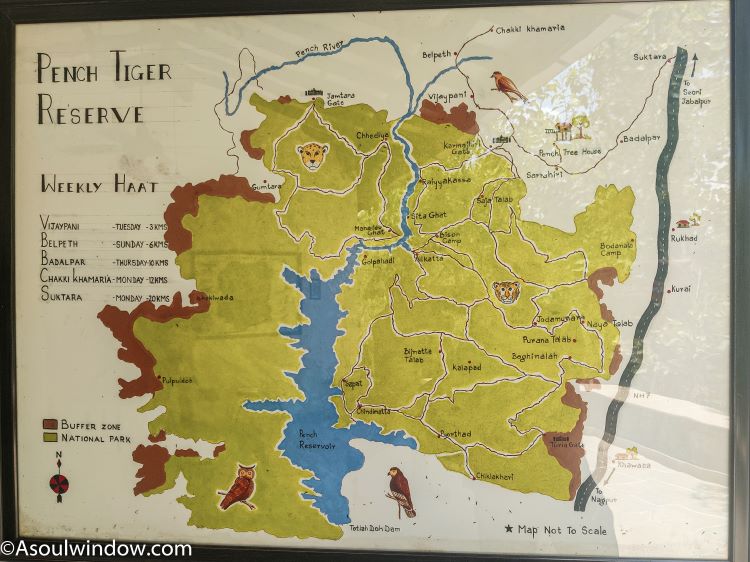
Visit Chhindimatta
A village used to once exist on the present location of Chhindimatta. You can still see the reminders in form of abandoned buildings and temples in the vicinity. In order to construct dam, the village was relocated elsewhere. At present Chhindimatta serves as pasture land which attracts many herbivorous animals. I think Chhindimatta is one of the most unusual places to see in Pench National Park.
Visit a village tantrik
You can also visit a local tantrik in one of the villages. I was told that Pachdhar village has a busy tantrik who is very popular with the local people. I have never met a tantrik in real life, so I chickened out when someone proposed the idea to meet him. But you must go for it if you have it in you. Ask around in Pachdhar village for the address of his home. It is a lesser-visited place around Pench National Park.
Doob Road
You can expect to spot large herds of gaur or Indian Bison in the Doob Road region post monsoon when there is abundant grass. Doob road is also known as sunken road because during the rainy season, this area remains submerged beneath water. After the monsoon season is over, the landscape turns into marshy grasslands, attracting various animals such as spotted deer, sambar, gaur and many endemic birds. The water levels here keep receding in winter and summer months. On a lucky day, you can even spot a leopard here. Nonetheless, driving along this track is still a pleasure, sighting or no sighting. Since this track runs close to the edge of the water bodies, expect beautiful views all around. The Kala Pahad area is also nearby.
Do birdwatching in Boda Tank
Birdwatchers come from near and far to enjoy multiple sessions of birdwatching around this irrigation tank. You can even see many migratory birds here during the winter months viz November, December, January and February.
Take a tour of Bodanala Range
You can expect to see natural variation in topography in the area surrounding the Bodanala Range. Situated in close proximity with the boundary of Pench National Park, it is a must visit place. Wild animals such as dholes or wild dogs are commonly seen around the Bodanala range. Movement of various species of reptiles and birds are also observed here regularly. Several grassy knolls, hills, marshy land, thick bamboo forests and ponds etc form the beautiful landscape here.
Do jungle safari in Turia Zone
This is one of the most well-known gates of Pench National Park. Turia Gate is popular for beautiful landscapes apart from good sightings of tiger and leopard. Turia gate is also the closest to NH 7. There are many points of attractions here. Turia Zone is a major sightseeing attraction in Pench National Park because it is good with sightings.
Enjoy the beauty of Karmajhiri Zone
You can do a jeep safari in Karmajhiri Zone as it is generous with easy spotting of Tigers, leopards, gaurs, jackals, dholes aka wild dogs and several species of birds. You can also visit Forest rest houses which are located here. Karmajhiri Zone is not as busy as Turia Zone but it is equally good with sightings. Karmajhiri Gate is located very close to the Pench Tree Lodge where I had stayed. I did the jeep safari in both Turia as well as Karmajhir gate.
Explore the Khursapar Zone on Maharashtra side of Pench
Lying in Maharashtra, you can spot Tiger and several bird species here. Apart from Turia zone and Karmajhiri zone, I have also done tiger safari in the lesser-known Khursapar Gate which is situated barely 12 kilometres away from the more popular Turia Gate, which is located almost on the border of Madhya Pradesh and Maharashtra. Strangely, Khursapar Gate of Pench National Park is located inside Maharashtra and not Madhya Pradesh. Khursapar is the top place to see in Pench National Park if you like to go off the beaten track.
Thanks to great tiger sightings off late, Khursapar Gate has gained immense popularity which it always deserved. On a good day, you can also see Gaurs, Chowsingha and Chinkara gamboling around. You can also visit the Bakhari lake hoping for more sightings. Khursapar core zone is also visually beautiful. Red soil, natural water bodies and undulating terrains are some of the features of the landscape of Khursapar. On the Madhya Pradesh side, the gates are Turia, Karmajhiri, Rukhad, Jamtara, the Night Safari gate and on the Maharastra side the gates are Khursapur, Surewani (Nagalwadi), Silari, Chorbahuli, Surewani (Nagalwadi), Kolitmaara and Khubada (Saleghat).
See Jamtara Zone
Sloth bears are regularly spotted in this zone. Also watch out for Sinduri and Banyan trees. I saw many Sinduri trees in Jim Corbett National Park as well. Jamtara Gate is also located close to Pench Tree Lodge. Safari in Jamtara zone is one of the most unusual things to do in Pench National Park.
Do safari in Sillari Zone
A part of Maharashtra Pench Reserve, it is inundated with thick bamboo and Teak forests. It is closed on Wednesdays. You can spot tigers, spotted deer, sambar, nilgai, peacock, jackals, gaur, wild boar and owl etc here.
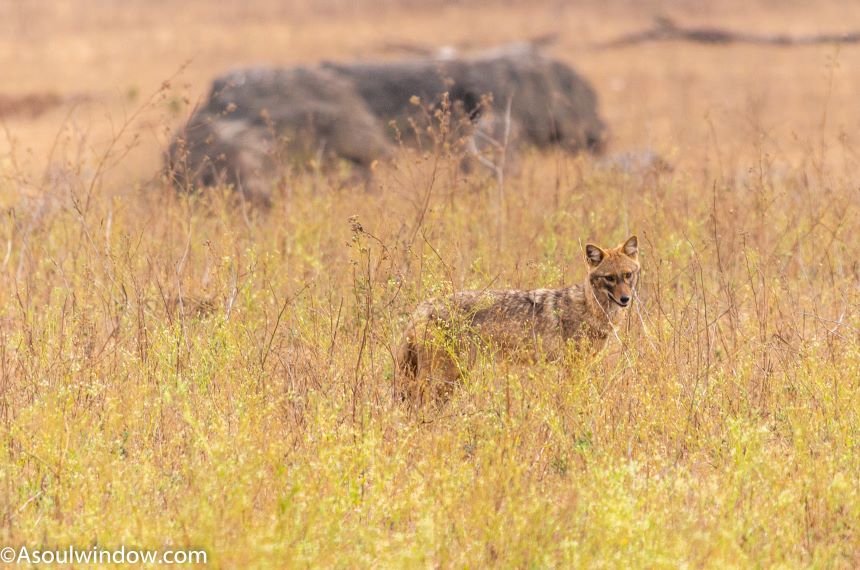
Explore Rukhad Zone
This is located in the buffer area. You can expect to spot tigers here. Jamun, Bamboo and Arjun Trees dominate this zone full of picturesque water streams. Don’t miss the colourful butterflies flitting along the moving safari jeep.
Visit Khawasa Buffer Zone
AlsoKnown as the Wolf Sanctuary, you can spot wolves, foxes and nocturnal birds here during the night safari. Khawasa buffer zone is located close to themore popularTuria gate.
Drive from Tadoba Andhari Tiger Reserve to Pench National Park
How far is Pench from Tadoba? It took me around 5 hours as I was driven to Pench National Park from Tadoba National Park in a cab arranged by Pugdundee Safaris. The long, lingering drives here are satisfying to the soul, thanks to the smooth roads and green surroundings. We passed through many beautiful jungles as we drove from Waghoba Eco Lodge in Tadoba National Park to Pench Tree Lodge in Pench National Park. The Vidarbha part of Maharashtra shares border with Madhya Pradesh in Central India. There are patches here when the road is roofed with canopies of dense trees.
Do sightseeing in Nagpur
There are many interesting places to see in Nagpur which you can visit while arriving at Nagpur airport or after checking out from your hotel in Pench National Park. Shri Ganesh Temple Tekdi, Deekshabhoomi, Zero Mile Stone and Sitabardi Fort are some of the top places to see in and around Nagpur.
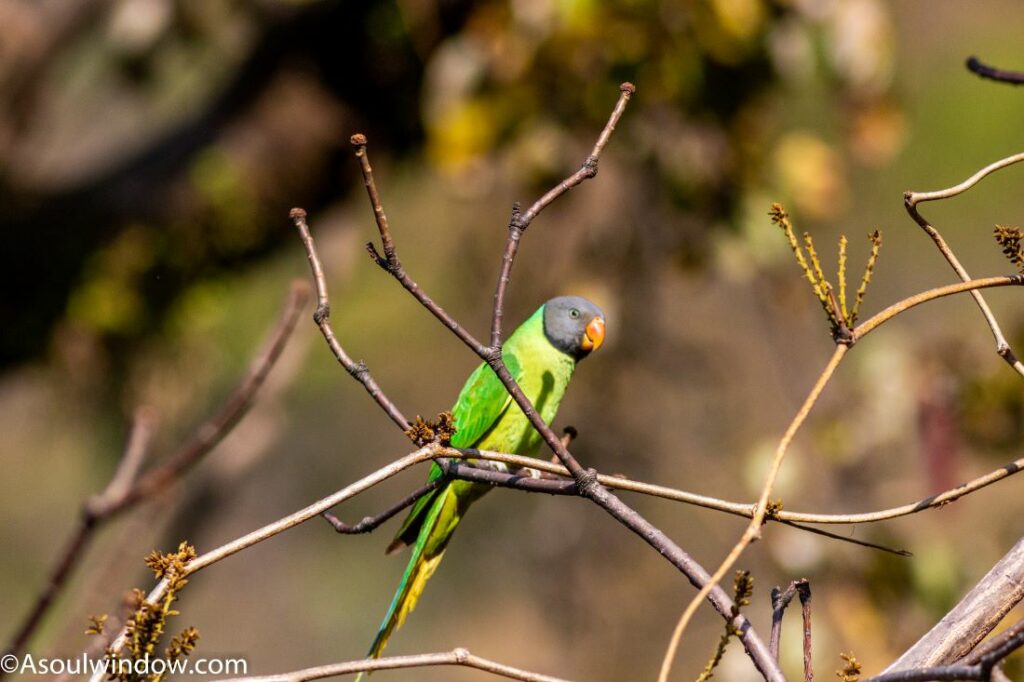
Frequently asked questions or FAQ
Which is the nearest town to Pench National Park?
The nearest big town from Pench National Park is Nagpur. I had alighted and left from Nagpur airport. There are many places of interest around Nagpur which you can add in your Pench National Park itinerary.
How many days do you need to see Pench National Park?
How many days do you need in Pench National Park? I feel anything between 2-3 days is ideal. However, if money and time is not a constraint, then a week-long stay around Pench National Park will leave you many more sightings and a deeper understanding of how the jungle works.
Which is better Tadoba or Pench?
The Tadoba versus Pench debate is an ongoing one. I visited both Tadoba and Pench National Park and am now qualified to finally have the last word. I had amazing safari experiences in both Tadoba as well as Pench National Park. While I saw the civet cat and jungle cat for the first time in Tadoba National Park, I saw the dholes and leopard for the first time in Pench National Park. Besides, I saw many tigers in both Tadoba as well as Pench National Park. So, I think both Tadoba and Pench are equally good with sightings and views. There are many sightseeing attractions in Pench National Park as well as Tadoba National Park.
Where is the best tiger sighting zone in Pench?
Which gate is better in Pench? Which is best safari zone in Pench? Which zone is best for Pench safari? These are some commonly asked questions. Turia gate, also spelt as Touria and Karmajhiri gate are good with tiger sightings. Both the gates are interconnected anyways. This is a lesser-known fact. You will not find such information in the mainstream media or old school, traditional guide books.
Which is the best gate for jeep safari in Pench National Park?
Which gate is best for Pench safari? Which zone is best for Pench safari? These are some commonly asked questions. I had an even more amazing safari experience in Karmajhiri zone than in Turia Zone. So, I think it all depends on the day and which zone a particular tiger is moving lately.
While Karmajhiri is located in the north, the popular Turia gate is located in the south of Pench National Park. Below is a list of all the gates of Pench National Park:
· Turia Zone
· Karmajhiri Zone
· Khursapar Zone
· Jamtara Zone
· Sillari Zone
· Rukhad Zone
· Khawasa Zone
Which gate is near from Nagpur for Pench?
Almost all the gates of Pench National Park such as Turia, Karmajhiri, Khursapar etc are located close to Nagpur for Pench. It took me barely 2 hours, for example to cover the distance between the Pench Tree Lodge near Karmajhiri gate to Nagpur airport.
Which month is best for Pench?
What is the best time to visit Pench? Summer months such as April, May and June are the best time to visit Pench due to easy visibility and more chances of tiger roaming or staying close to water body. Having said that, my friends had great sightings even in the winter months. I have personally visited Pench national Park in both winter and summer.
Winter
I visited Pench National Park in mid-February. The weather and climate during February was very pleasant and not cold. I was able to wear a shirt in February and not feel cold. Visiting Pench National Park also gave me the opportunity to see several migratory birds such as Ruddy Shelduck, also known as Brahminy duck or Tadorna ferruginea. December and January are very cold in Pench National Park though. Temperature is very low in peak winter here.
Soul Window Connections
Ladakh (Maru) I have also seen Ruddy Shelduck at the Mansarovar Lake in Tibet during the epic Kailash Mansarovar Yatra and Mongolia where it is considered to be sacred.
Summer
My second visit to Pench National Park was in the peak of summer, which is mid-June. I visited just before the park was about to close for the monsoon season. I was rewarded with one of my most successful safaris yet where I saw dholes and leopards for the first time, apart from tiger, gaur etc. Pench National Park Tourism in May, June, July has high success rate of sightings.
Soul Window Wows
Thanks to the soaring temperatures, the big cats roam out in the open near water bodies in summer months. This made sighting easier for me. No wonder, we saw a total of 6-7 tigers, including cubs over 3 safaris in Pench National Park and Tadoba National Park in mid-June.
Monsoon
The Pench National Park remains closed during July, August and September. However, you can still do safari in the buffer zone during the rainy season. This is the most exhaustive travel guide on Pench National Park. Do read the section on why you must visit Pench National Park in monsoon
Which days Pench National Park closed?
Pench National Park remains closed in monsoon months, i.e. July, August, September and mid-October. Pench National Park remains open between 15th October to 30th June. I visited mid-June and was rewarded with amazing sightings.
Are mobiles allowed in Pench?
Yes, mobile phones are allowed in Pench National Park. I shot my vlog on mobile phone itself. Some outdated articles may say that mobile phone is not allowed which is far from the truth. This is why I decided to write this elaborate travel guide to Pench National Park to debunk the myths.
What not to do in jungle of Pench?
Do not make noise, shout or carry any inflammable items. Also, do not carry away any thing from jungle such as leaves, antlers which have been shed etc. Do not chase wild animals. Rather wait and let them walk towards you or near you (yes, that works!)
Why is Pench National Park famous?
What is the Speciality of Pench National Park? Pench National Park is known for its high density of Royal Bengal Tigers. What also makes Pench so popular is the fact that the sightings are easier here. You can also spot jackals, gaurs, dholes and even leopards easily in Pench.
How to reach Pench National Park?
Pench National Park is an worthwhile weekend getaway from Nagpur. Located on the boundary of Seoni and Chhindwara districts of Madhya Pradesh, close to Maharashtra’s northern border, Pench National Park is easy to reach.
By air
I arrived in Nagpur at the Dr. Babasaheb Ambedkar International Airport also known as Sonegaon airport or Nagpur airport. From the airport, I was picked up by the cab sent by Pugdundee safaris. I visited Tadoba National Park first, followed by another 5 hours cab from Tadoba to Pench National Park.
By car
How much time it takes from Nagpur to Pench by taxi? We covered the 135 kilometres long Pench Tree Lodge (Karmajhiri)- Suktara – Nagpur airport route within 2 hours.
By rail
Nearest big railway station from Pench National Park is located at Nagpur.
Pench National Park Itinerary
On the same trip I and Ami covered both Tadoba National Park as well as Pench National Park in 5 days. Let me show you how we did it. I am sharing below the entire trip breakup:
· Day 1 – I reached Nagpur in the afternoon and was driven 2.5 hrs to Waghoba Eco Lodge in Tadoba National Park
· Day 2– Morning safari in core zone of Khutwanda, evening night safari Navegaon Ramdegi Gate of Tadoba National Park.
· Day 3 – We did nature walk/ cycling in the morning. Then we spent morning at leisure at Waghoba Eco Lodge in Tadoba National Park. By 10 a.m., we were transferred to Pench Tree Lodge over a 5 hrs long cab ride. We did evening session at Kipling Hide from 3 p.m. to 6 p.m. after lunch
· Day 4– Morning safari and afternoon nature walk followed by farm dinner. We did bird photography again in Kipling Hide between 3 p.m. and 6 p.m.
· Day 5 – Morning safari in Karmajhiri Zone of Pench and then transfer to Nagpur
What are the timings for safari in Pench National Park?
What time is the evening safari at Pench? What time can you enter Pench National Park? Below are the answers to your frequent queries. I am mentioning below the entry and exit time for both morning and evening safari and in both winter and summer season:
Winters (October to February)
Morning safari: 6:30 a.m. to 11:00 a.m.
Afternoon safari: 2:30 p.m. to 6:00 p.m.
Summers (March to June)
Morning safari: 5:30 a.m. to 9:30 a.m.
Afternoon safari: 3:00 p.m. to 7:00 p.m.
Night safari
What are the timings for night safari in Pench National Park?
Night safari: 6:00 p.m. to 9 p.m.
Who is the famous tigress in Pench?
Collarwali, who is also known as Matharam is the most famous tigress of Pench National Park. During tiger safari, we ventured close to her area many times. T 15 or the queen of Pench was born in the year 2005. There are many reasons why she is a celebrity tiger in Pench. Mother to 29 cubs, she passed away due to old age in the year 2022. She was more than 16 years of age.
Are there black panthers in Pench National Park?
Is Black Panther in Pench National Park? Yes, melanistic leopards have been spotted in Pench National Park. But they are very rare to see. Every once in a while, their videos keep going viral on social media. They are also known as the ghost of the jungle. Since they are so rare, they are also most celebrated.
What do you wear to Pench?
Since I did safari in the peak summer, I wore light cotton clothes. On another safari in winters, I wore layering and woollen clothes. Early mornings and late evenings can be very cold in Pench National Park, so prepare as per the weather.
Which days Pench National Park closed?
Pench National Park remains open throughout the year except for the monsoon season, which is July, August and September. On Hindu festivals such as Deepawali and Holi, the park remains closed.
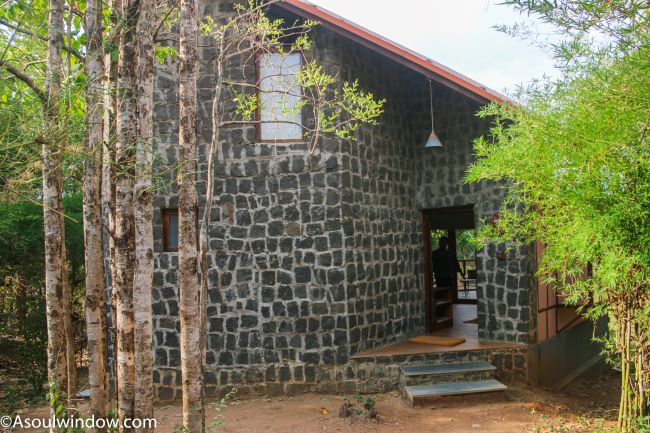
Conclusion: Is Pench National Park worth it?
What is there to do in Pench National Park? Why to visit Pench National Park? Here is an overview. Pench National Park, which is an easy weekend escape from Nagpur is a must-visit place. Whether it is sighting or a walk in the Gond villages, or birdwatching or activities such as cycling, boating, dam visits, treks etc, there is a lot to do in Pench National Park. Pench National Park, which falls in both Madhya Pradesh and Maharashtra can also be easily combined with a trip to Tadoba National Park in the adjacent Indian state Maharashtra.
Do share this complete guide to Pench National Park with your friends and family. This is the biggest guide on Pench national Park, available anywhere. I have shared deep insights in this detailed travel blog. Thanks to my own experience and deep research, I have explained all you wanted to know about Pench National Park in great details. What are you waiting for? The land of Mowgli, the wolf child beckons!
Related Blogs
I have written many detailed blogs on wildlife. Below are my other blogs on wildlife from India and other countries.
Birdwatching trip in Shitlakhet
Birdwatching trip in Lakh Bahosi
Birdwatching trip in Sonkhaliyan
Kaziranga National Park Experience
Manas National Park Experience
Chitwan National Park Experience
Hoollongapar Gibbon Sanctuary Experience
Kidepo National Park Experience
Bwindi Impenetrable National Park Experience
Top Travel Blogger from India
